
Old World Tile review
I’ve seen this brand of flooring online, but it is very pricey. The various descriptions state the tile sheets come with a stylus for detailing the grout lines and end up looking very realistic. I’ve not seen any photos of it installed in a dollhouse or room box, though. I think perhaps the retail price of $25 per sheet (plus shipping) is a bit steep to buy it without knowing how it will work out.
Well, I ended up finding an unfinished sheet on eBay for a fraction of the cost, though it didn’t come with the stylus indicated. I figured it was worth a try.
It’s a very high quality printed paper that you adhere to an included white board with spray adhesive. The grout lines are raised on the print.
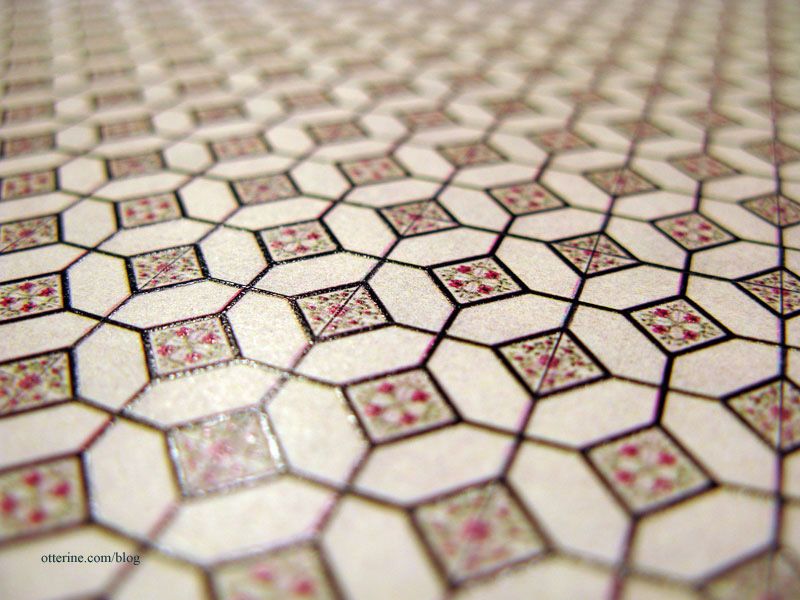
The instructions are very precise, including exactly which products to use for the assembly and finishing of the flooring. I cut my board to my room size and used scraps to try out the sealing process.
The manufacturer suggests up to five coats of Delta Ceramcoat Gloss sealer applied with a brush. Here is the sample I did following those instructions.
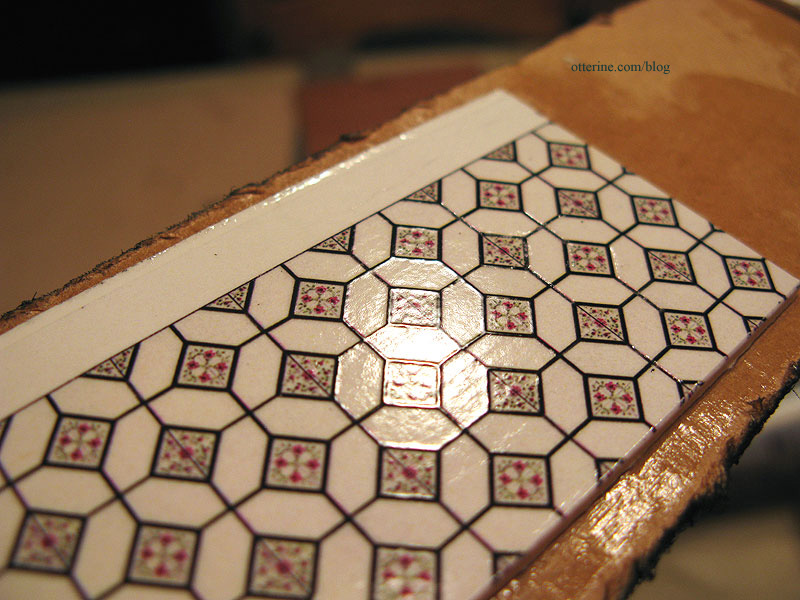
I also covered a sample by brushing on one coat of Triple Thick Gloss Glaze by Americana. Here is the sample with that product.
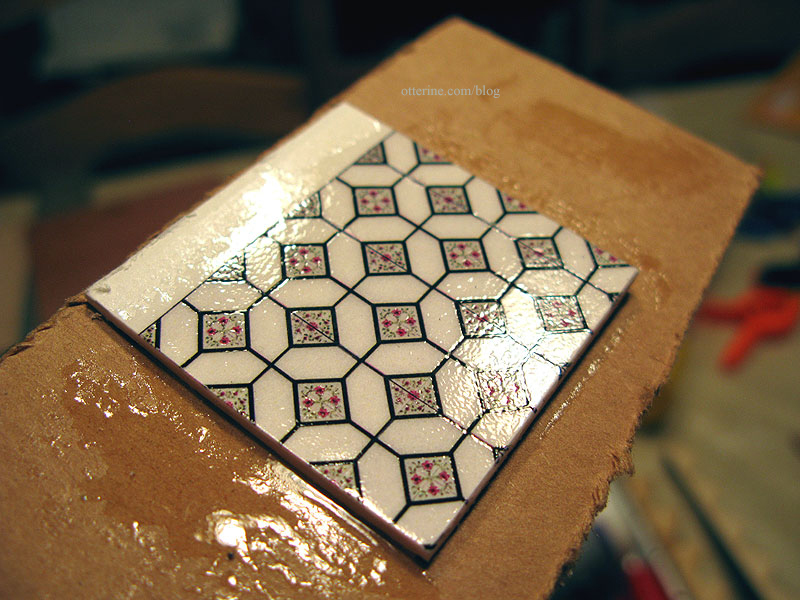
I think I’d need more coats of the first sealer to equal the results I got with the one coat of Triple Thick Gloss Glaze, and there are no brush lines with the Triple Thick. It evens out as it settles and dries. I rather like that it looks like sheet linoleum, too!
You are then supposed to use the stylus to lightly score along the lines, indenting the finish but not the paper to create the look of recessed grout lines. I tried the scoring process with my own stylus but found it didn’t really work for me. It marred the finish even though I wasn’t pressing hard at all.
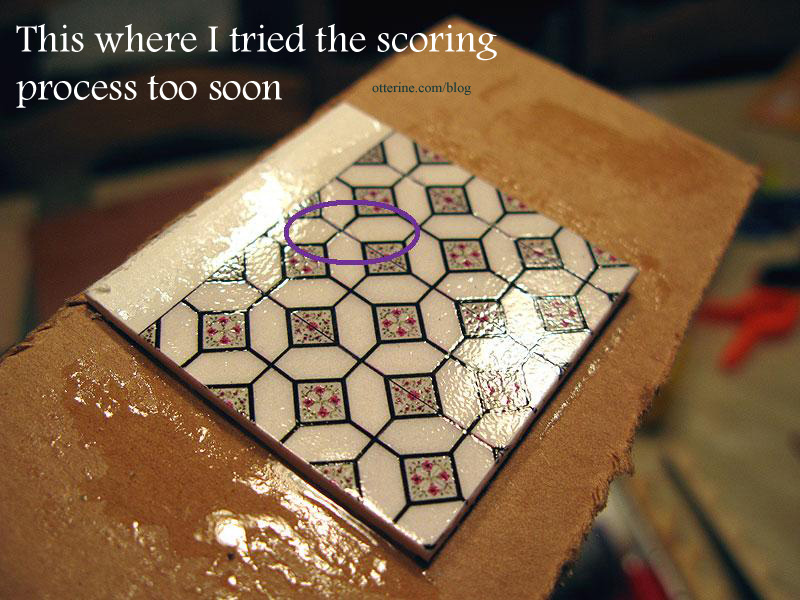
I thought perhaps I hadn’t let the finish dry long enough so I tried it again the following night. It worked without lifting the sealer but I honestly didn’t think it added anything so fabulous to merit the amount of work it would take to trace all of those tiny lines. And, any mistakes would be irreversible. So, I am opting for the Triple Thick finish without the scored lines.
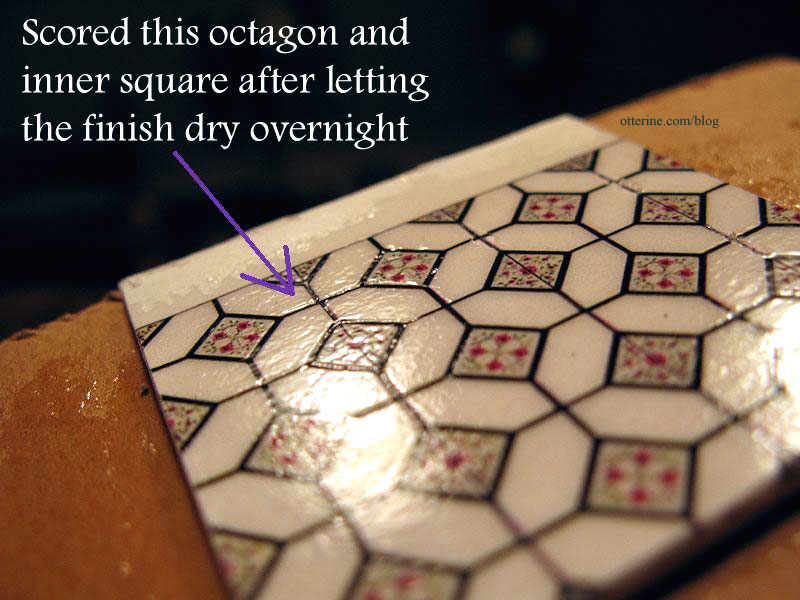
With this particular sheet, I was able to do one room of flooring with enough left to do a tiny room for another project, or perhaps a backsplash, counter or serving tray.
It really is a beautifully made and realistic flooring, but I still think $25 per sheet is too much regardless of including a stylus that could just as well be sold separately. You really wouldn’t need a new stylus included each time you bought a piece of flooring from this product line.
Categories: Baxter Pointe Villa
May 13, 2011 | 0 commentsNewport – master bath cabinet
Back to work on the master bath in the Newport. Here’s the view from where I left off.
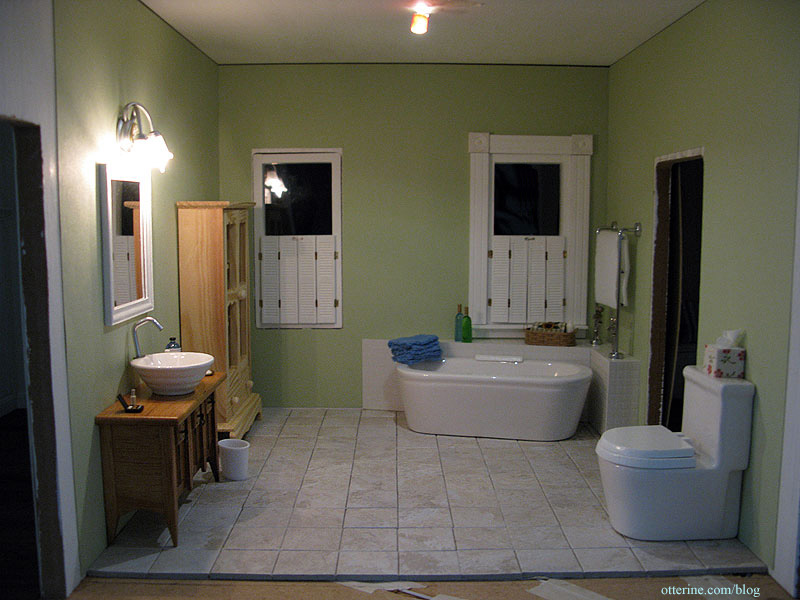
The original Michael’s cabinet (shown in the photo above) I had as a stand-in seemed too country for this more modern bathroom, so that one moved back into my supplies. I thought about using a Houseworks bookcase instead, but it was too big and open. Not everything you keep in a bathroom should be on display. ;]
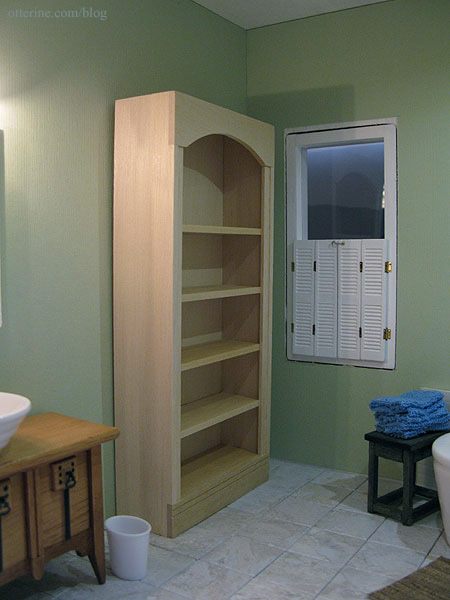
So, I put two House of Miniatures kits together to make a custom cabinet: a Closed Cabinet Top (which I left open) and a Hutch Cabinet.
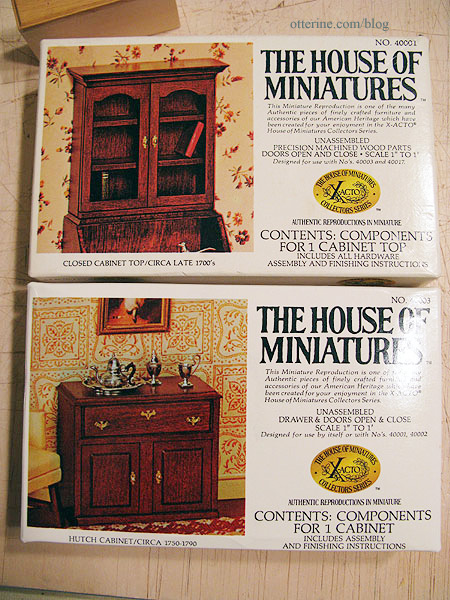
I stained the pieces IKEA antique pine and sealed with Delta Ceramcoat satin varnish before assembly. I wanted to tie the cabinet in with the vanity (a Mackintosh sideboard) since there was getting to be too much white in this room. The knobs are jewelry findings painted with Testors flat black enamel.
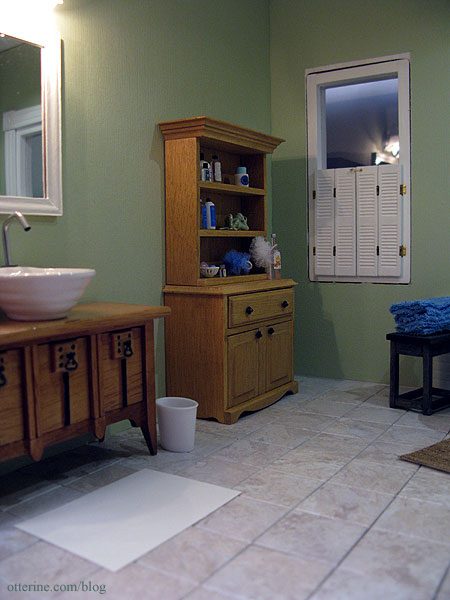
I left the doors off the top part to have some place to display minis. :]
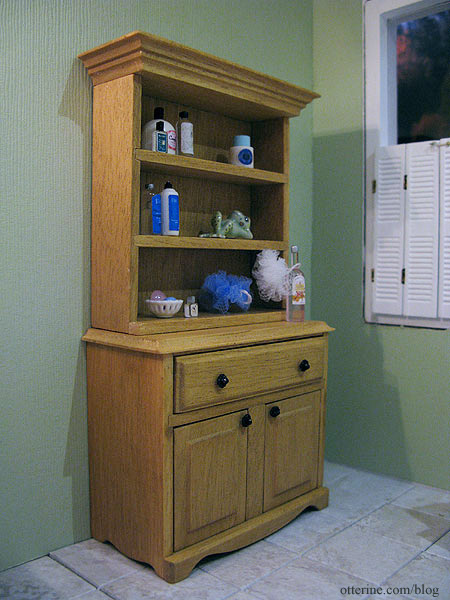
I hid a few things inside, too! I made the towel but bought the other minis.
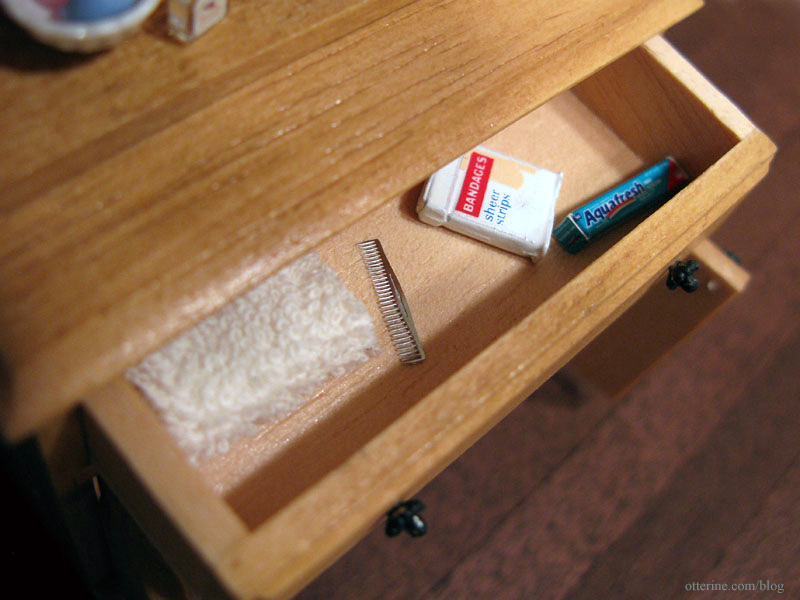
The towels were made from terry cloth from fabric.com. I had to fold a few in various ways to figure out the sizes that would fit and look true to scale in the cabinet before gluing them into their final shapes. The bottles are various types of blanks I picked up here and there (except the Listerine bottle, which I bought along with the toilet tissue).
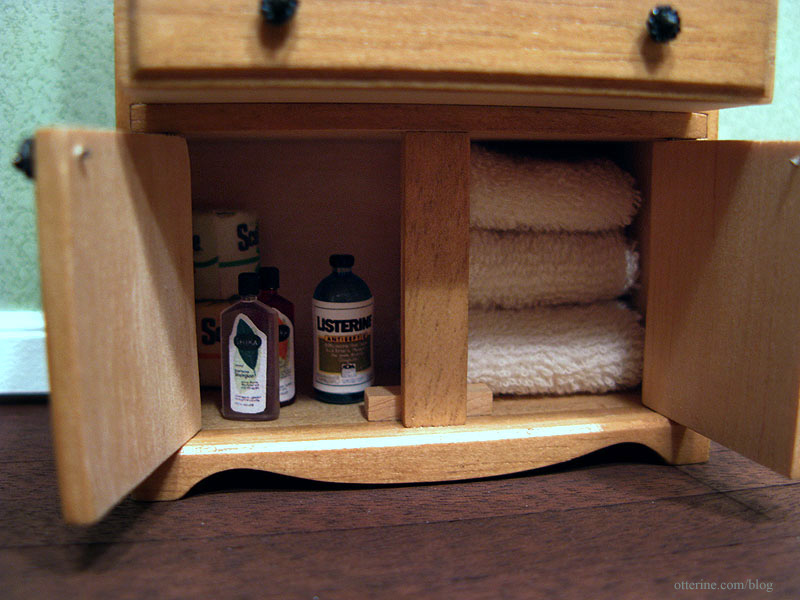
I found images of product lines I liked online and printed a few labels on white Avery sticker labels (though I still needed to supplement the adhesive with a glue stick for some). The bottle shapes and colors don’t emulate the original products exactly, but I like them! :]
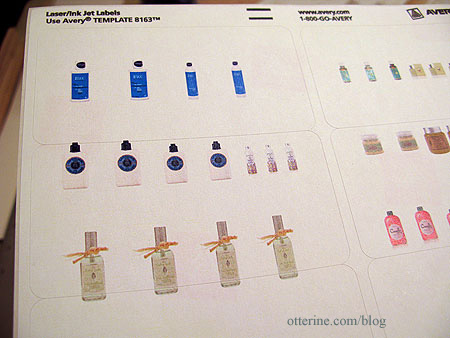
Here’s a better view from the front.
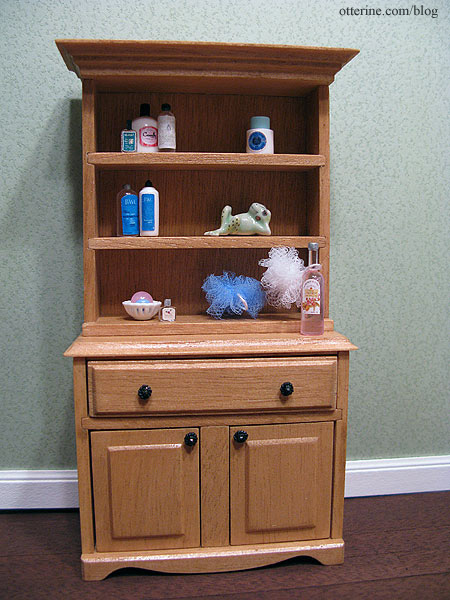
The loofah scrubbies were made from fine tulle also from fabric.com that I sewed together with white thread twisted to form a rope.
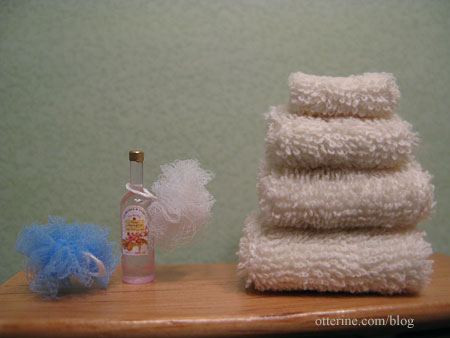
If you want to see how impossibly tiny some of these bottles are, just check out the penny on the lower shelf. That tiny clear bottle has a label that measures 1/8″ square.
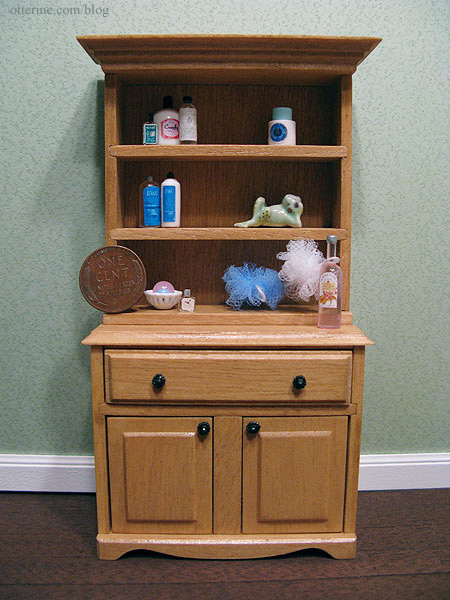
I love this little guy! :D
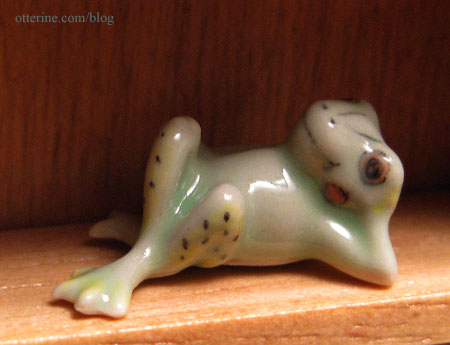
There will be a better setup added in time, but this is where I’ve started.
Categories: The Newport
April 27, 2011 | 0 commentsBaslow Ranch – a pictorial review
Baslow Ranch is my first completed dollhouse. The overall feel I went for with this project was that of a late 1880s building that had been updated over time with electricity and other “modern” features of the passing times. It now sits as an open air, living museum to remind us how people lived and worked. I relied heavily on my trip to Bodie, CA – an open ghost town where you can walk around and explore – as well as other living museums I have visited.
I’ve named the Spring Fling structure Baslow Ranch, established in 1888. The name is in honor of several of my recent pets: Basil (pronounced bazzill), my beloved cat who passed away in September 2009; Clover, a sleek and beautiful Chinese dwarf hamster; and Willow, a Russian dwarf hamster who went through a lot in his long life and held on tenaciously until the very end.
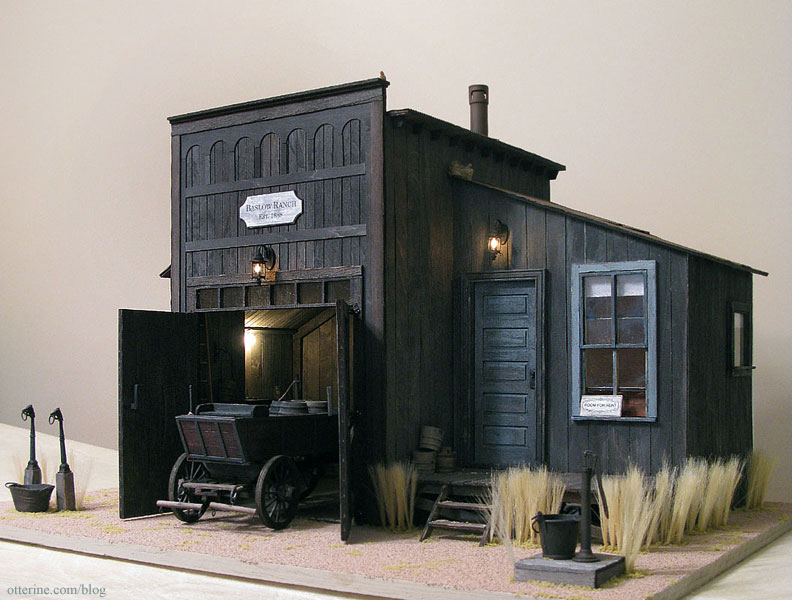
There is an attic space, a room for rent and a barn. I tried to make as much as possible for this project, not only to stay on budget but to see what I could accomplish on my own. The things I didn’t make include: lights, buckets, barrels, as well as the glass, ceramic and metal minis. Of the minis I bought, however, I still changed most in some way by either painting or weathering or both.
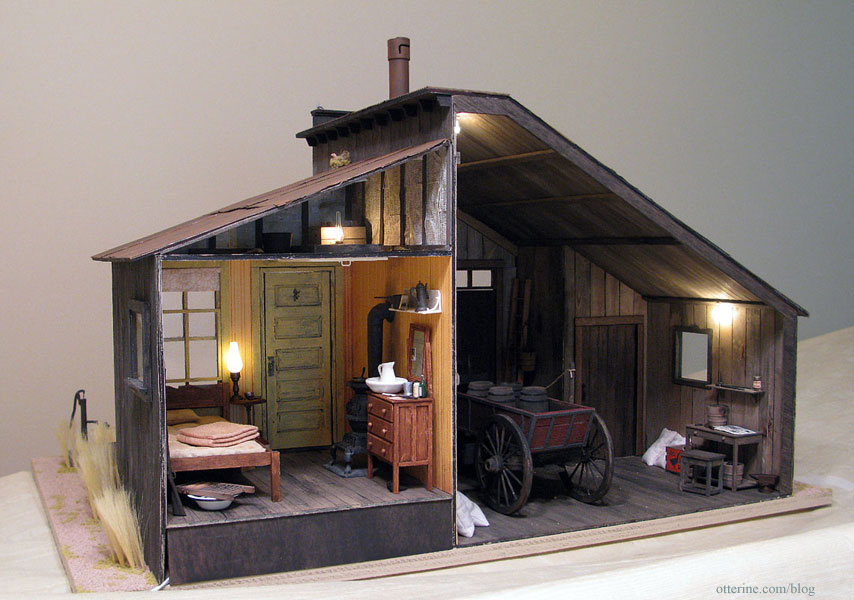
The room for rent has the basic comforts. The wallpaper is scrapbook paper called Simple Stripes/Grandma’s Kitchen by We R Memory Keepers. It’s fantastic since it already has that worn and aged look printed in the design.
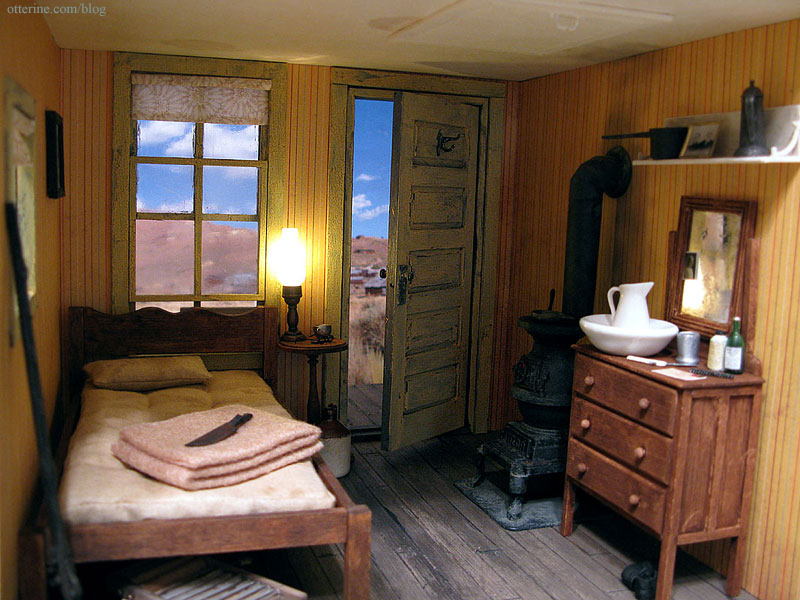
I used the base kit for the contest and the optional side room with the first dry fit on March 26, 2010. This was my first time working with a Greenleaf kit. The 1/8″ plywood walls gave me some fits with the warping, but the laser cut pieces were great to work with. Overall, I loved this kit!
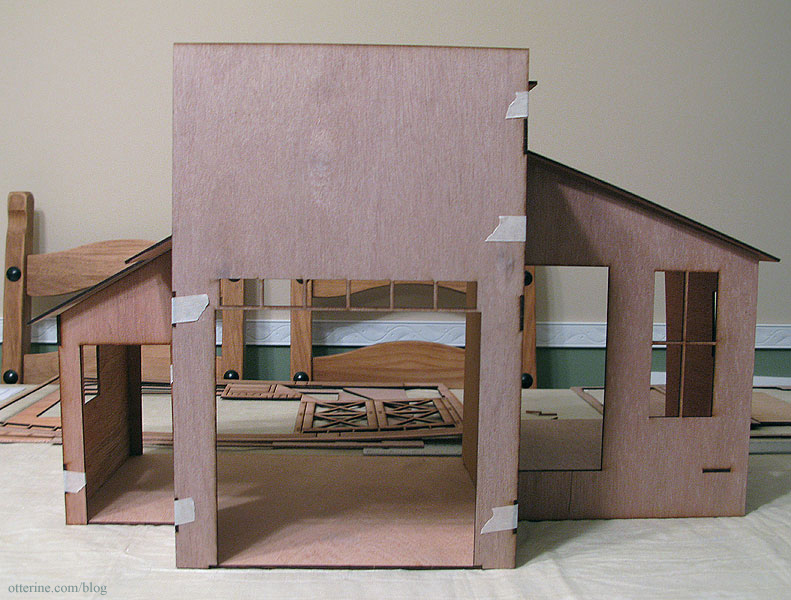
The backdrop I used in some of the shots is a photograph I took in Bodie, CA. This was a great place to visit – a bit of a chore to get there but more than worth the effort (bring a hat and sunscreen!). I took over a hundred photos walking around this open museum ghost town.
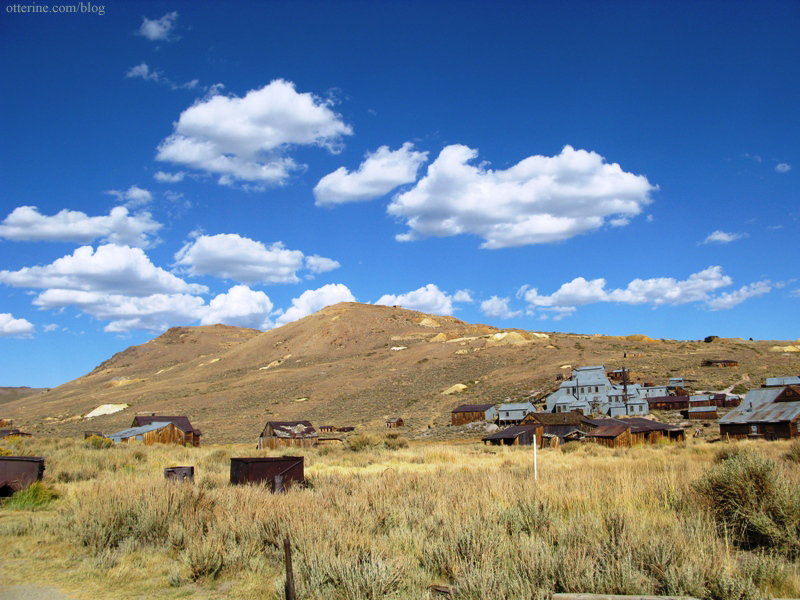
Attached to the main barn is a room for rent.
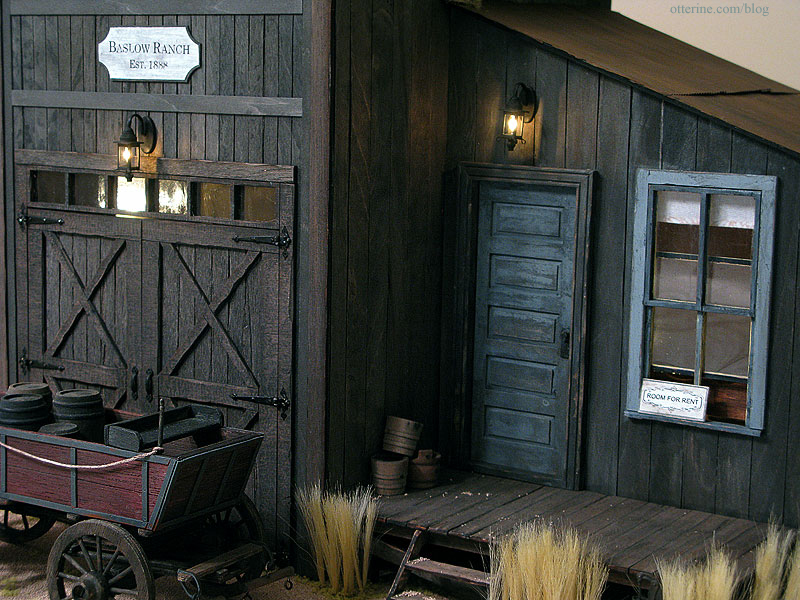
Both the sign above the barn doors and this one were created in Word and printed on paper. I glued the paper to a wood backing and aged with paint washes.
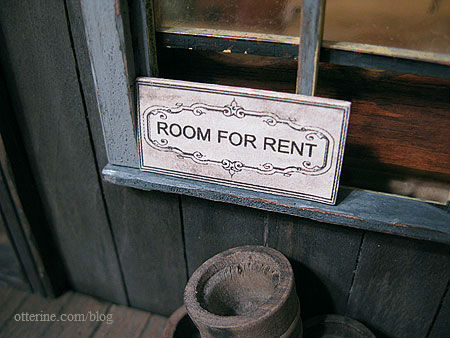
The windows, door and trims were first aged by beating, cutting and otherwise marring the finish and applying a wash of brown and black paint. I applied Crackle Medium by Folk Art and then painted Sunflower yellow by Folk Art.
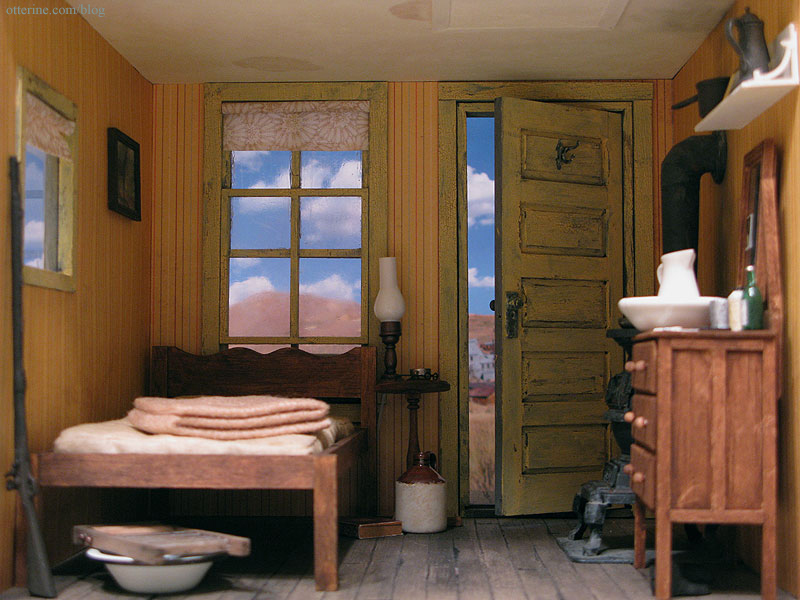
I made the stove from a Chrysnbon plastic kit. I found this kit to be both realistic and very easy to assemble. Although the kit came in plastic molded in the proper color, I still sprayed all of the pieces with Testors flat black. I also sprayed the chrome pieces since I wanted this to look like an old stove without any fancy accents. I added a red bulb to simulate warm coals.
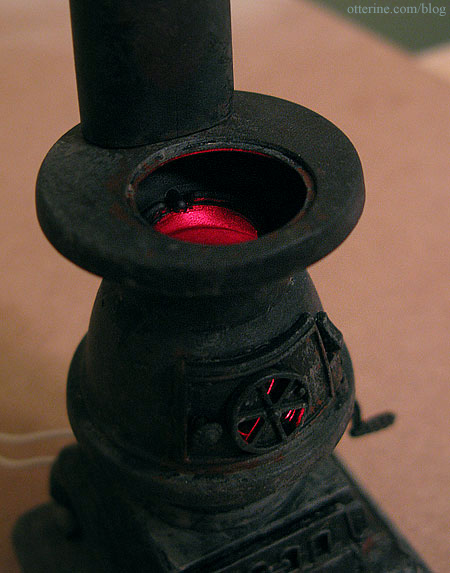
To achieve the aged look, I dabbed on Mushroom acrylic paint by Folk Art and a paint by Testors appropriately called Rust. :D
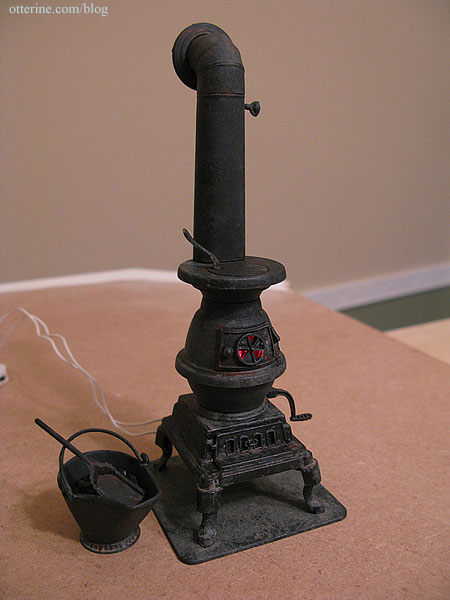
I painted the wires black and glued them to the inside of one of the back legs before feeding them through the floor. I used an X-Acto knife to shave dust from a black conte crayon and used a dry brush to dirty the wall and ceiling around the stove.
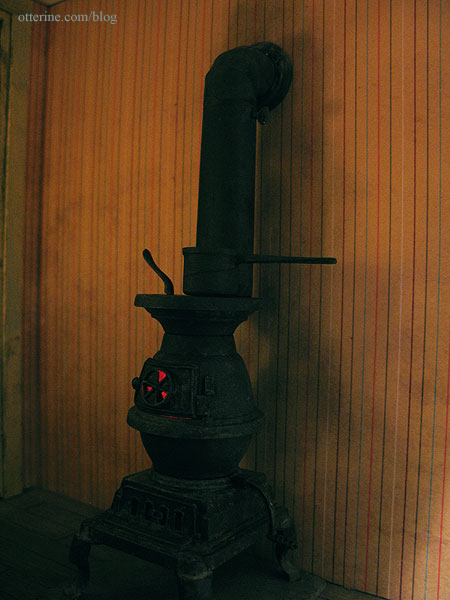
The lower interior window is removable so I can have the window partially open or closed completely. To age the glass (acrylic), I brushed on some Gloss Varnish by Delta Ceramcoat and then wiped away the excess. It took a few turns of this process to get a realistic look. The rolling shade is made from a scrap of fabric glued around a wooden dowel.
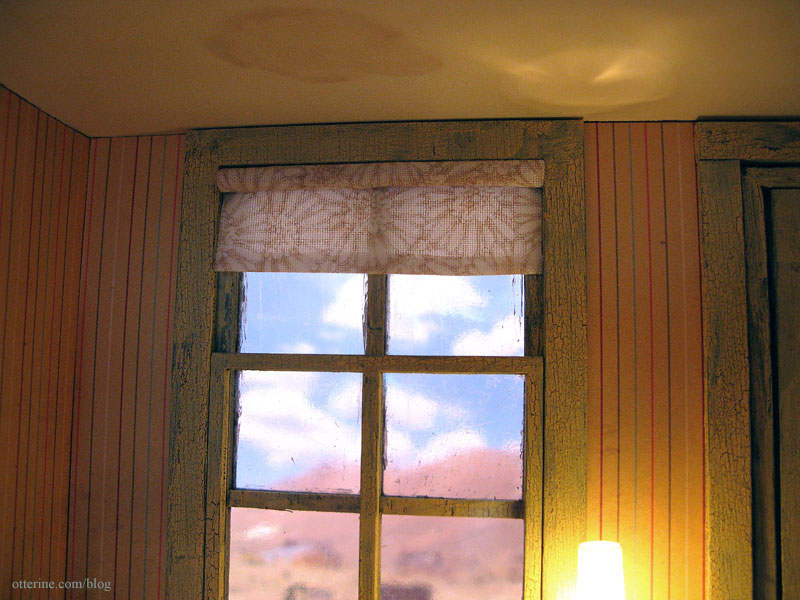
When the backdrop is in place, it really feels like you’re standing in a real life room. :D
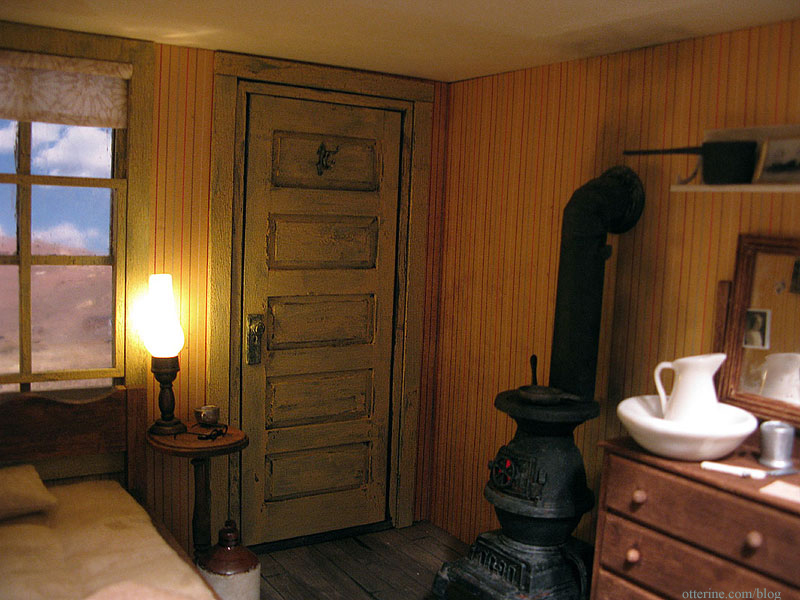
The dresser with the mirror was made from a pattern in Thirties & Forties Miniatures in 1:12 Scale by Jane Harrop. This project was labeled advanced, and though it was a real bear cutting all the pieces precisely, I love the way it turned out. I stained all of the pieces with IKEA antique pine stain before assembly and then aged it with Antiquing Medium by Folk Art after it was built.
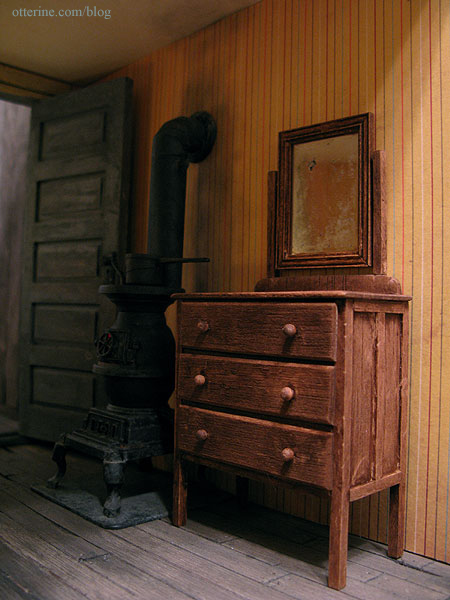
The mirror is made from plastic mirror sheet by Darice. This material was great to work with. The finish was pristine when I pulled it from the package, so I had to beat it up a bit for it to blend with the old dresser. I used an X-Acto knife to scrape some of the backing away. This created spots in the reflection. Using the same process as I had for the windows, I brushed on some Gloss Varnish by Delta Ceramcoat and then wiped away the excess. I painted the wood backer black as well. Now it looks like an old weathered mirror.
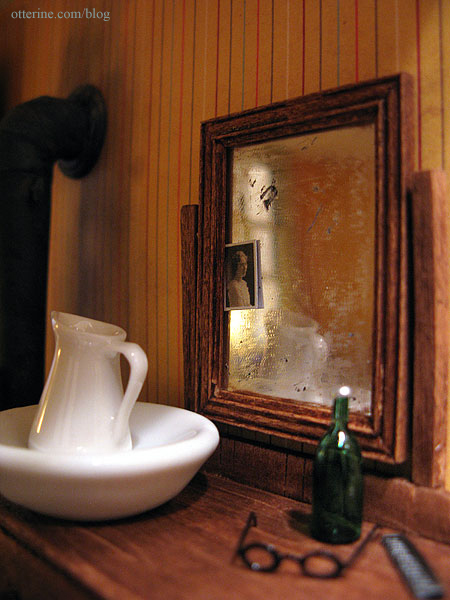
The apothecary items were made from a glass bottle and an unpainted metal miniature. I used brown paint to dirty the glass and painted the metal bottle with acrylics. I then glued on tiny antique medicine labels I found online. I crinkled the label on the metal bottle before gluing it since the bottle itself seemed a bit beat up. The razor and shaving mug were unpainted metal minis that I detailed. The shelf was made using pieces from my scrap wood bag.
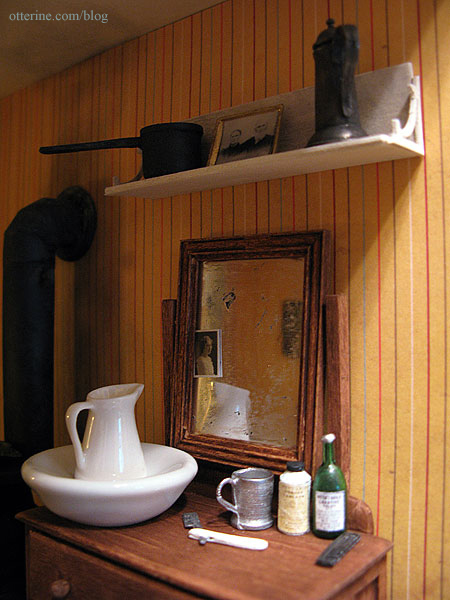
I’m a big fan of hidden elements, so while I didn’t make any actual miniature clothing, I did place some folded fabric scraps in the drawers. :D
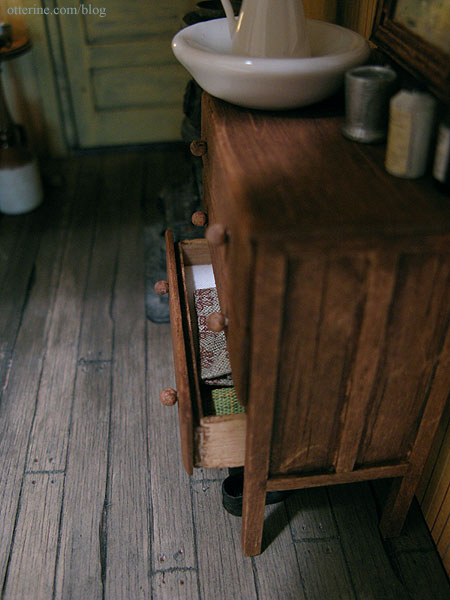
The horse painting is Horse with Wagon at Hitching Post by Edward Lamson Henry. I sharpened the image a bit and then printed it on Art Canvas, a specialty paper by The Crafty PC. I made the frame from strip wood. There’s no particular significance to the painting – I just liked it. :]
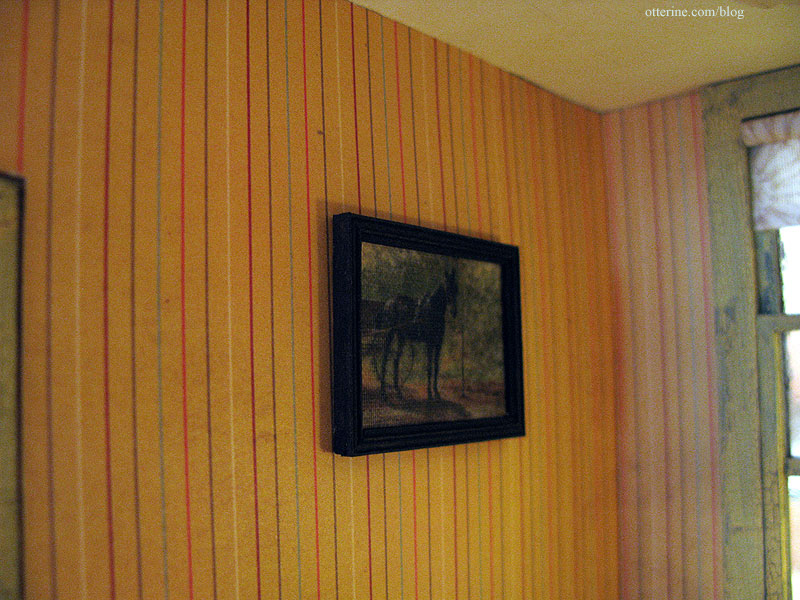
Attic access is simulated with a faux trap door (I used the tutorial on the Greenleaf site). I used a brown paint wash to create water stains on the ceiling and trailed an X-Acto knife from the corners of the attic door to create cracks. I painted over the brass handle in the process. If you’ve ever seen an old house, you know painting over hardware was a common practice. :]
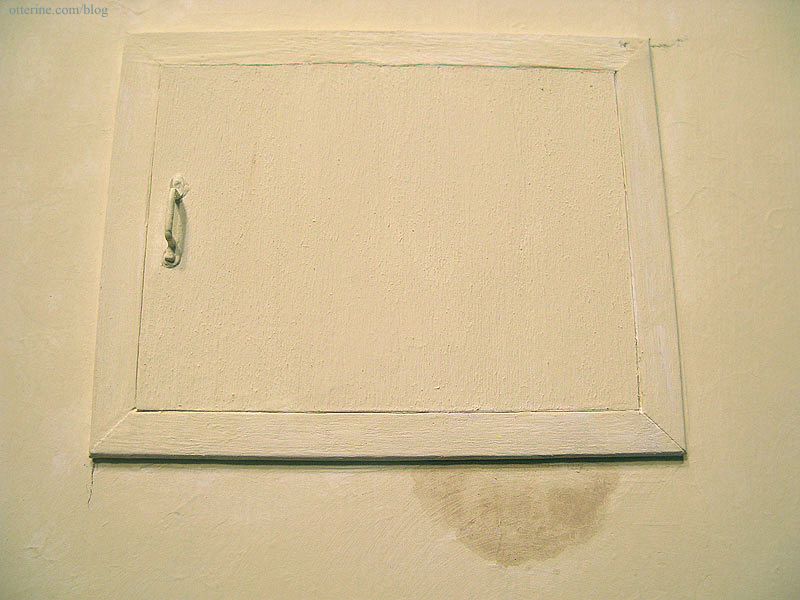
The washboard was made from a pattern in Thirties & Forties Miniatures in 1:12 Scale by Jane Harrop. The parts are all fixed in place, but I love this piece. It turned out better than I had hoped. The metal is the same material I used for the roof, run through a Fiskars crimper.
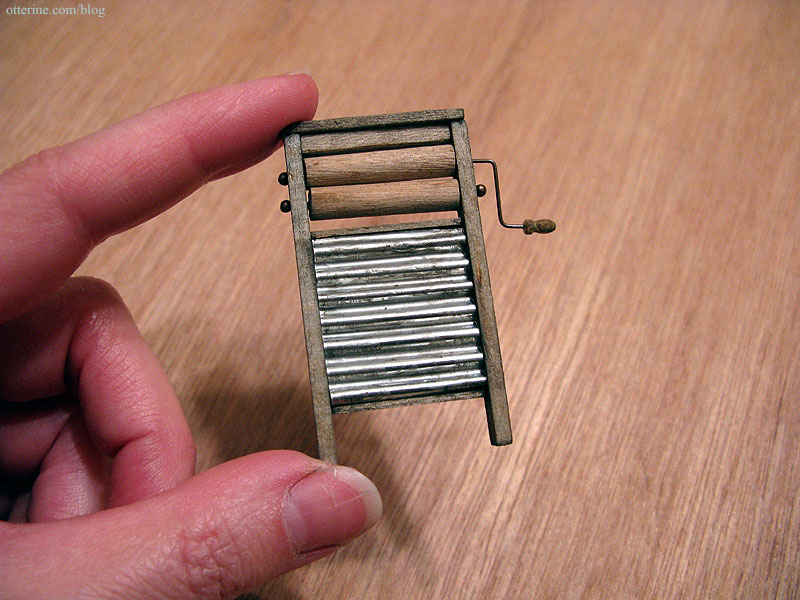
The bed was made from a House of Miniatures single low post bed kit. I left off the fancy post tops for a more rustic look. The mini bedside table is also from a House of Miniatures kit, from a set of two side tables. I stained both with IKEA antique pine stain and then weathered with Antiquing Medium by Folk Art and a slight wash of black and brown paint.
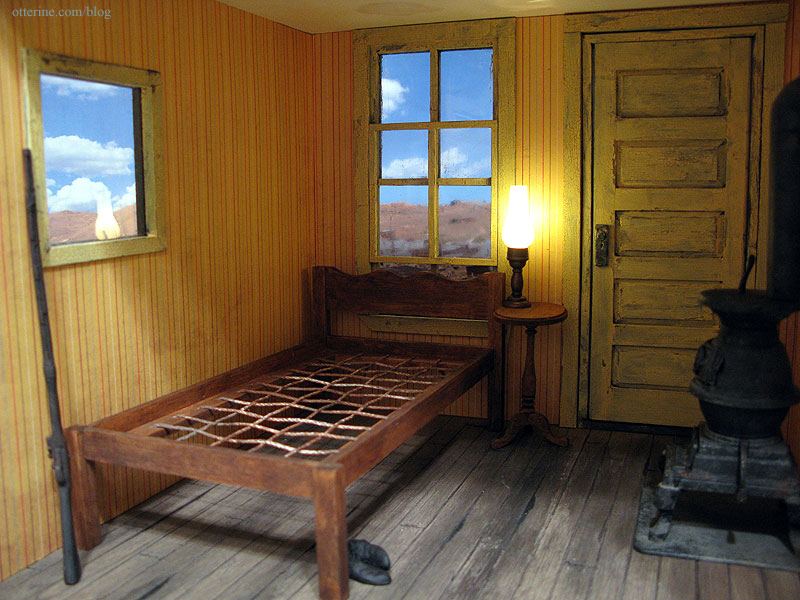
The mattress was made from fabric that had an old, stained look to it, stuffed with four layers of a felt-like batting and quilted. I love the way the bed looks with the ropes exposed, but I wanted the option to show it either empty or fully dressed.
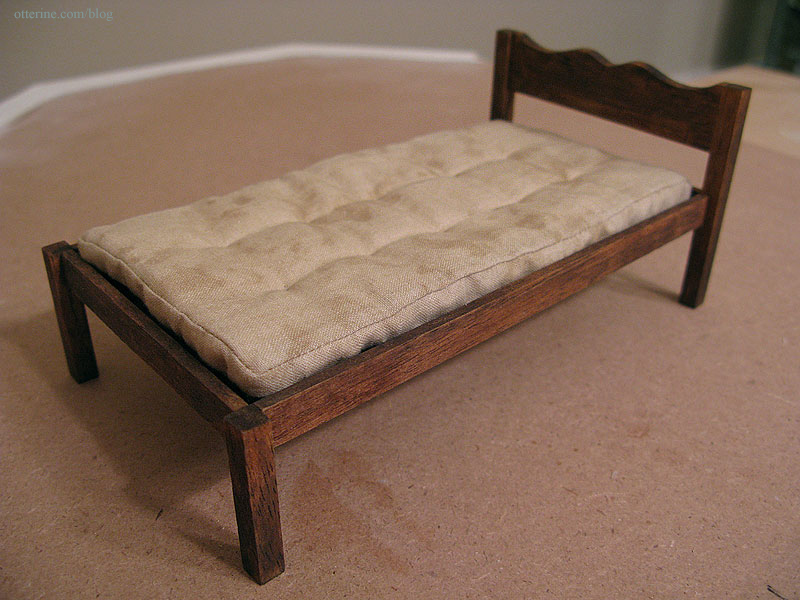
There are a few artisan-made knives with leather sheaths on the market, but I decided to give it a try myself. I started out with a kitchen knife with a red handle. I painted the handle black and then made a sheath with a belt loop out of scrapbook paper called Buckskin Brown by The Paper Company. I used a bit of black paint to age the paper once the glue was dry. The blanket is a folded piece of felt pressed into shape with an iron.
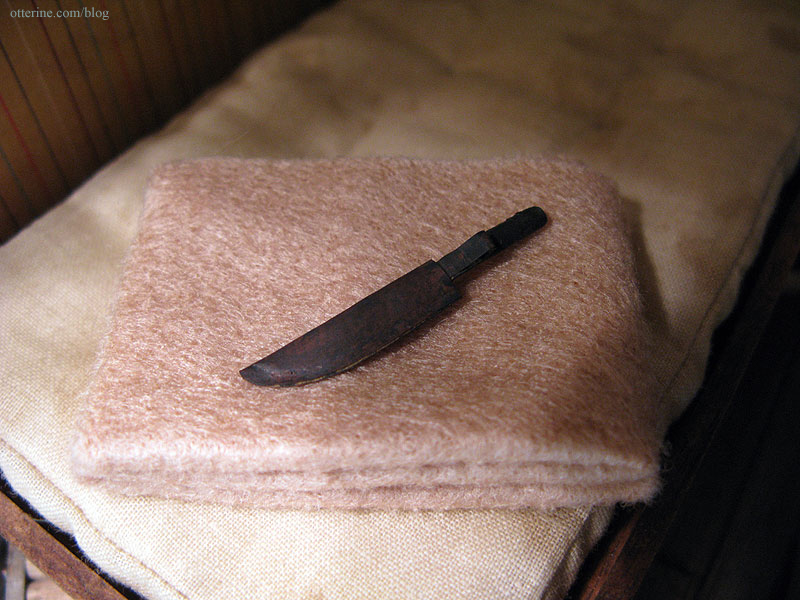
A couple of more personal details I included are the photographs of my own ancestors. The young woman on the mirror is my great grandmother Mary Jane Bartlett (nee Watson) in her graduation photo. She was born in 1900 and passed away in 2005 just shy of her 105th birthday. She was young at heart and lived on her own until a few months before she passed. She wasn’t even hard of hearing; she cooked her own meals and cleaned her own home. She was a remarkable woman with a terrific laugh, and I am lucky to have known her well into my adult life.
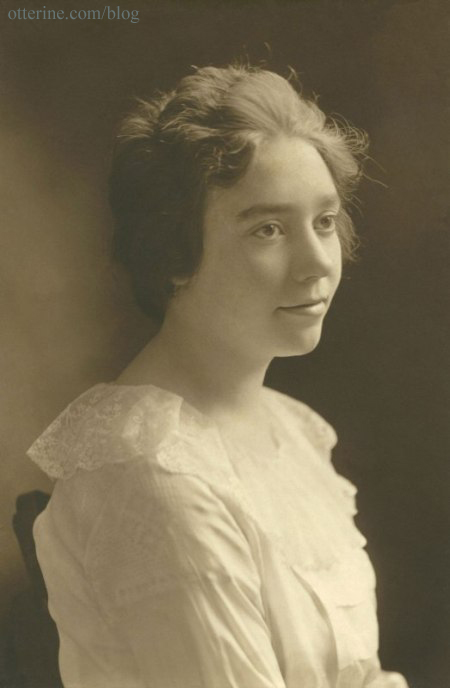
The second photo is that of her grandparents: Augustus Samuel Watson (1827-1901) and Mary Jane Cameron (1827-1900). That would make them my great, great, great grandparents.
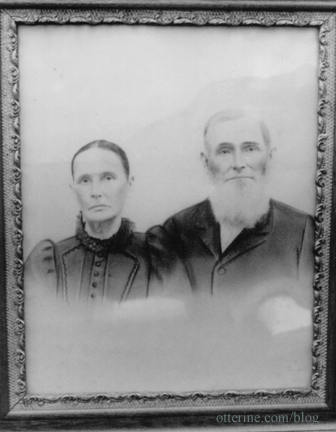
A close up of the sign and light over the barn doors.
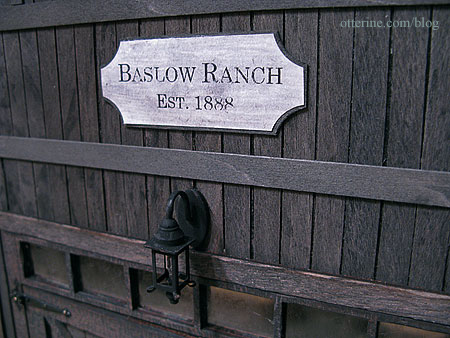
The doors and windows provided with the original kit offered some nice details but I wanted to go a step further. I found an image of a fraternity house in the ghost town of Elkhorn, Montana that had some very nice lines on the front. I used cardboard and a large circle punch to create similar arches and cut strip wood to complement the design. I used the punch to create the sign, too.
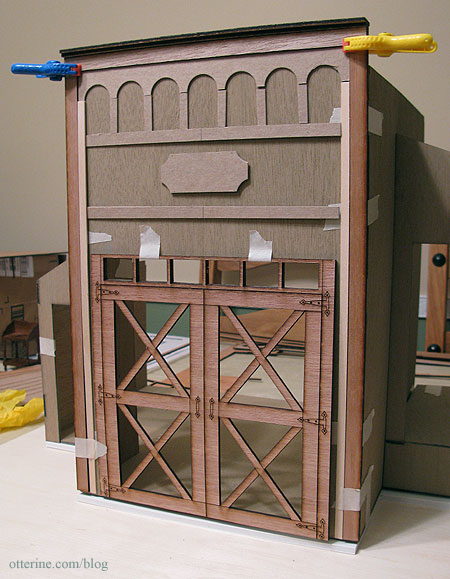
The siding application and finishing was quite a process, and I have a detailed post on that here.
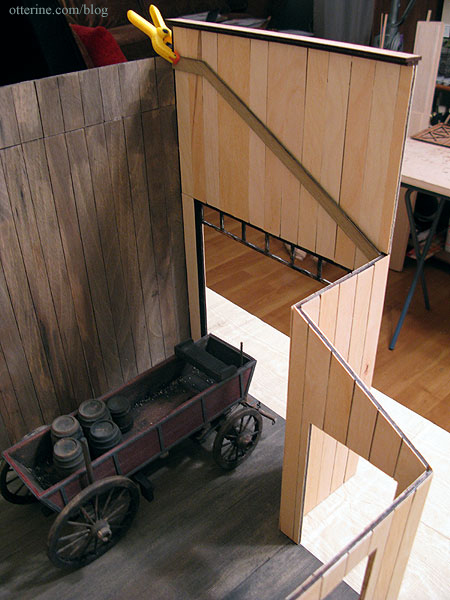
I flipped the direction of the Houseworks door so it would open in to the left.
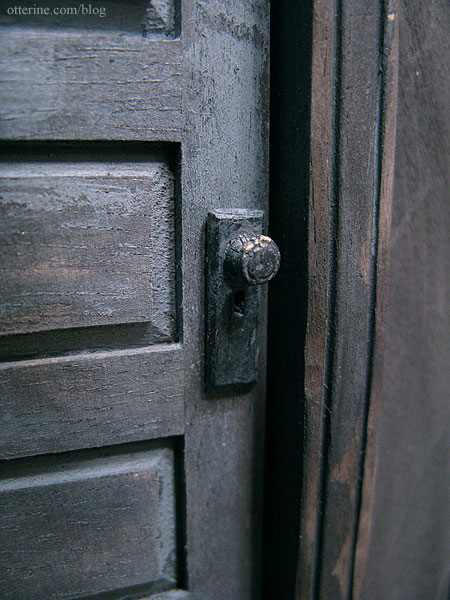
The feed and flour sacks have my own custom made designs printed on fabric. The horse and cow are rubber stamp images I found online; the sunflower is clipart. I designed the text and layout in Word. Since water will ruin the printed images, I first ran the fabric through the printer using a tea-stain color. I then printed my images on that darkened and aged background. I left the bottom half of the fabric sheet plain so I would have excess for the backs.
I filled the bags with beads to make them easier to position. I have no idea if these are historically accurate, but I just love the way they look! I also love the knot in the plank – I just had to use that piece when I found it.
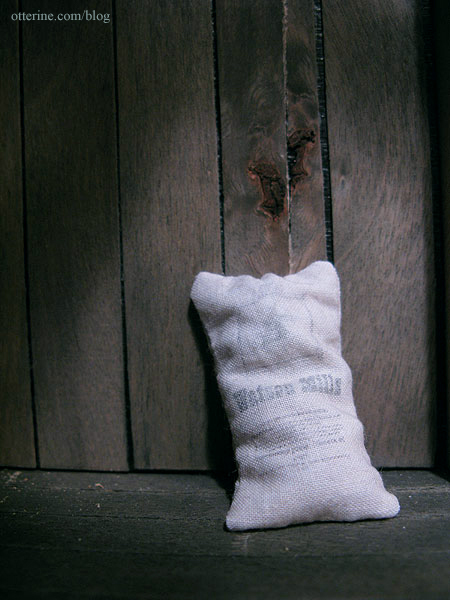
I made a ladder based on a pattern from Making Miniature Gardens by Freida Gray.
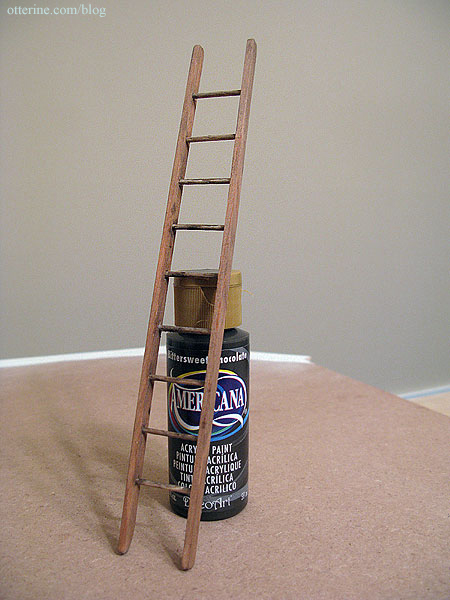
I used a scratch built board latch on the inside of the main door; the small metal latch I had used on the side door wasn’t substantial enough.
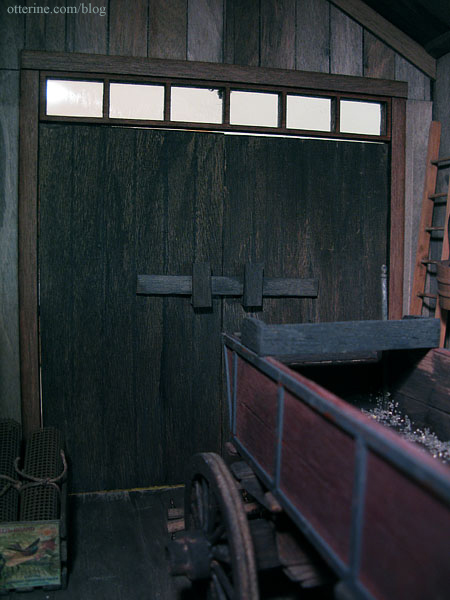
The crates are made from strip wood and skinny sticks, aged with a black and brown paint wash. I found these vintage labels online and printed them on parchment paper. They, too, have a light wash of black and brown paint to age the paper. I had planned to make more of these, but with all of the other things in the barn, I didn’t need a lot. The Blue Goose image is from thelabelman.com; I don’t recall where I got the other.
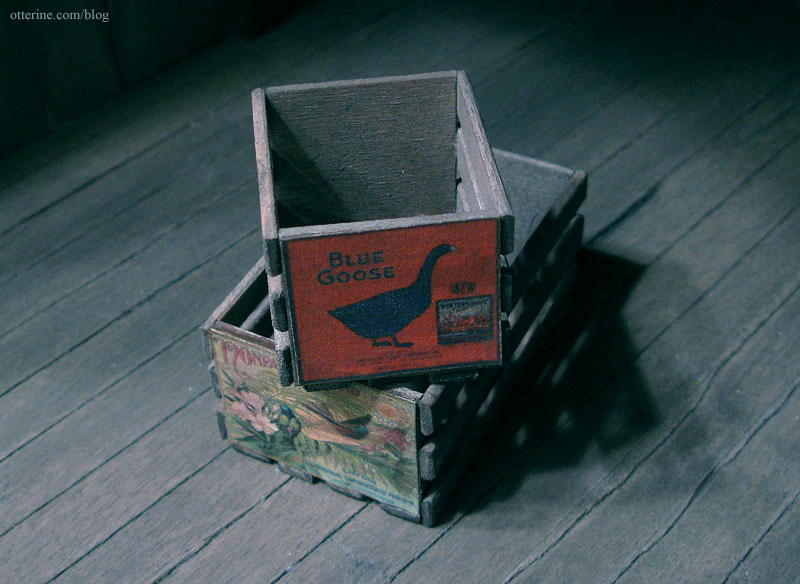
Most of the metal tools and accessories were made from unpainted pewter miniatures. I first sprayed them with a coat of Testors flat black and then used regular acrylics to detail them.
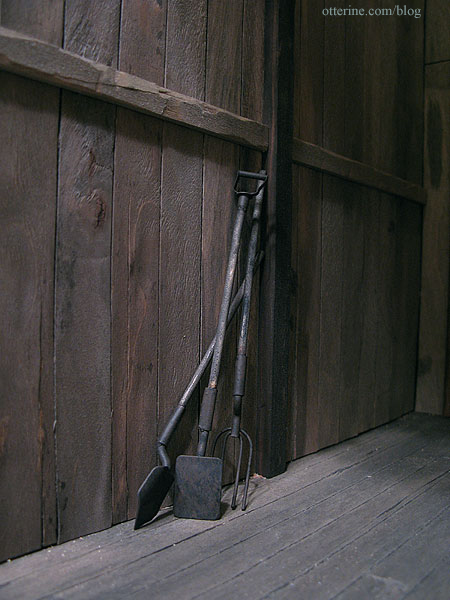
To hang the tools along the beam, I found something I never knew existed. I was looking for scale railroad spikes on the internet and found these Mini RR Spikes for 5th String Capo meant for banjos. Who knew?!
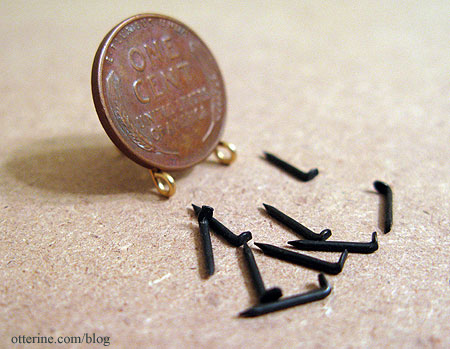
I’m not sure if they are exact to scale, but they work wonderfully and don’t look out of place. I drilled pilot holes into the beam and then pressed the spikes in place. They worked perfectly for holding tools on the wall. The rolled up fencing is actually a piece of flat metal mesh called Hannah’s Helper scour screen that I found in the cleaning aisle of Jewel. I painted it brown, cut it in half and tied the rolls with leftover rope from the bed kit.
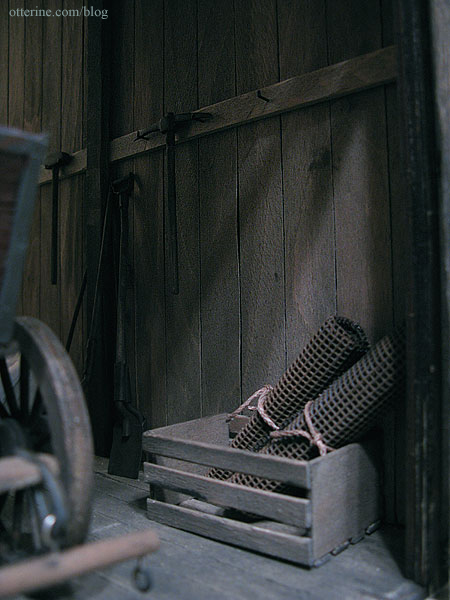
My wagon was adapted from a covered wagon kit by Allwood (made in the 70s, I think). I changed it from a covered wagon to a farm wagon since the kit was 1:16 scale and, as a covered wagon, it would have been a bit small in relation to the barn. Here’s the box image.
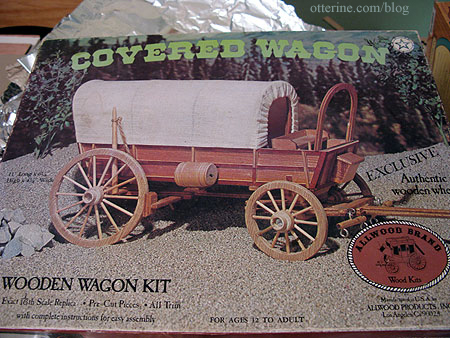
The kit was partially assembled when I bought it. Three of the four wheels were already done as well as the main body. The faux wood trim didn’t look right (think wood paneling on an old station wagon), so I ended up taking the body apart altogether and cut new pieces from a scrap of plywood I already had. This allowed me to score the inner and outer surfaces of the pieces to mimic wood planks.
It’s a good thing this was meant to be a rickety ol’ wagon, because the wheels are nowhere near straight. Three of the four wheels were assembled by the previous owner, but I my fourth wheel wasn’t much better. The chassis and basic structure are solid, though.
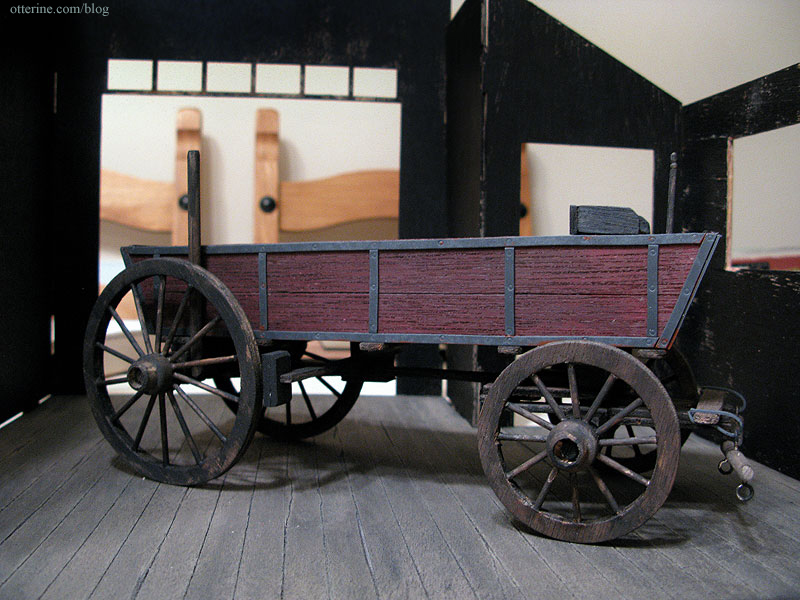
It ended up fitting perfectly in the barn space.
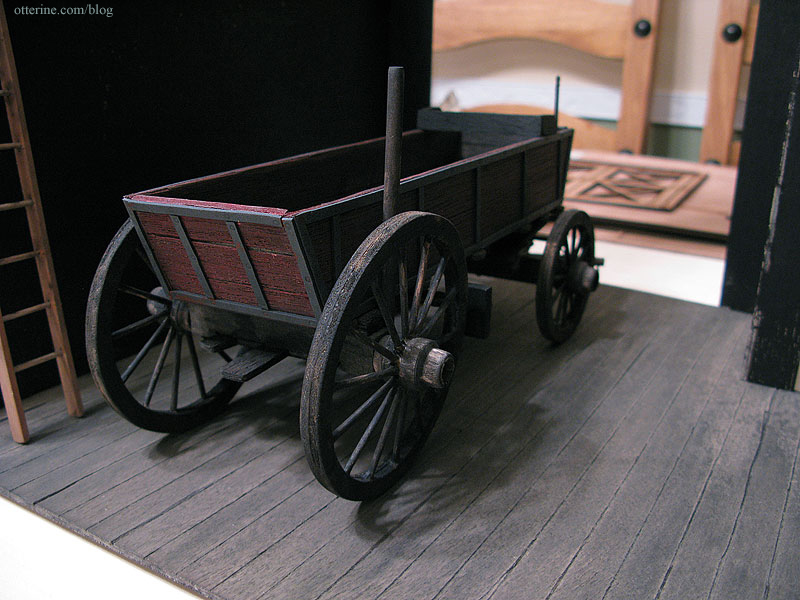
I made the stool using a pattern in the book Finishing Touchesby Jane Harrop.
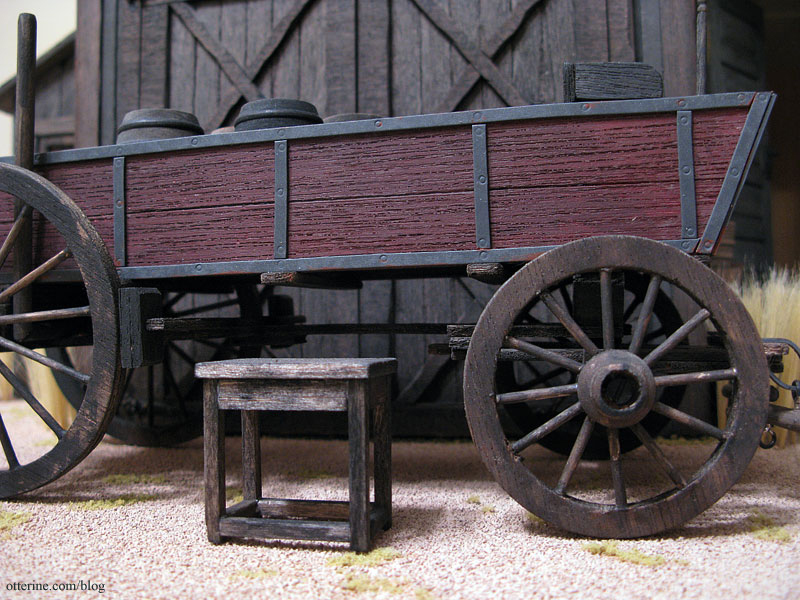
It, too, was aged with the black and brown paint wash.
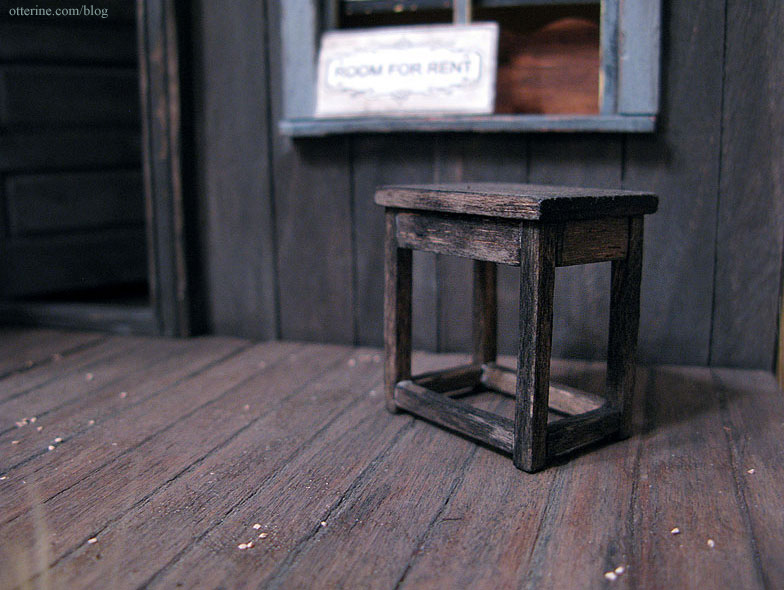
The wagon has a removable tongue, too, though it makes the wagon too long to park inside the barn with the doors closed.
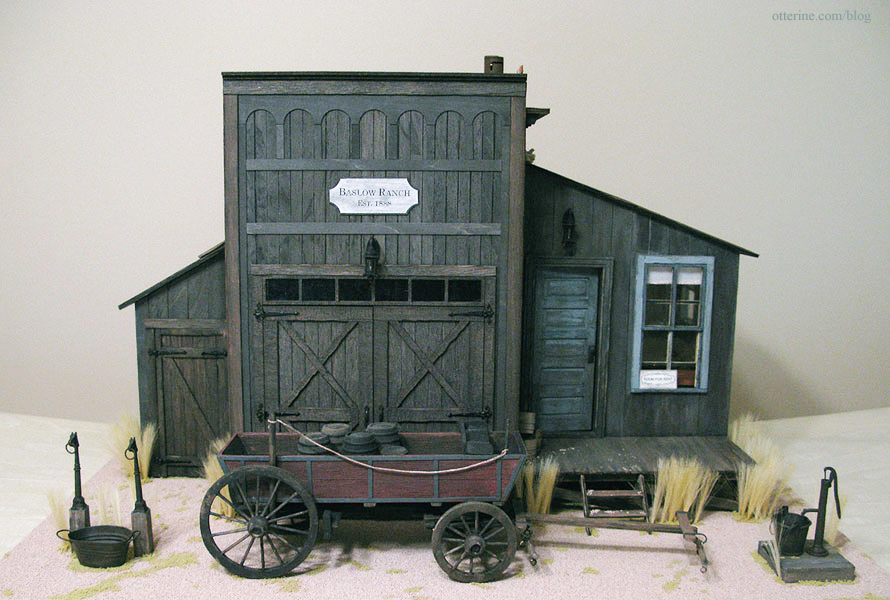
I added a removable back wall with siding identical to the other interor walls. This makes for a realistic backdrop when viewing the wagon through the open barn doors.
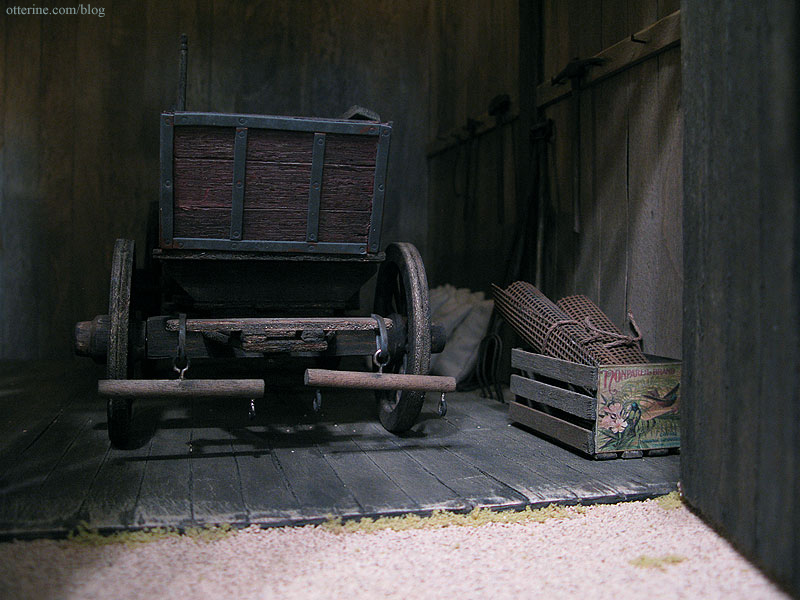
I used working hinges for the barn doors, dabbing black paint to cover the brass nails. I also used black paint to color in the original laser etched hinges since my working hinges didn’t cover them completely.
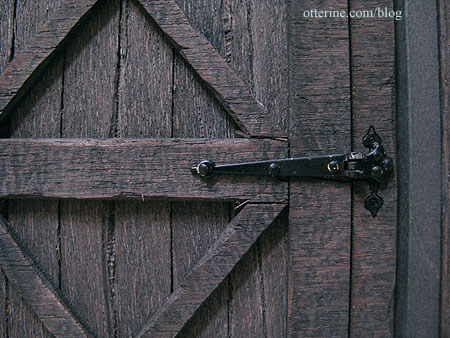
I especially beat up the edges of the boards and exaggerated the laser scored lines and cuts along the front edge.
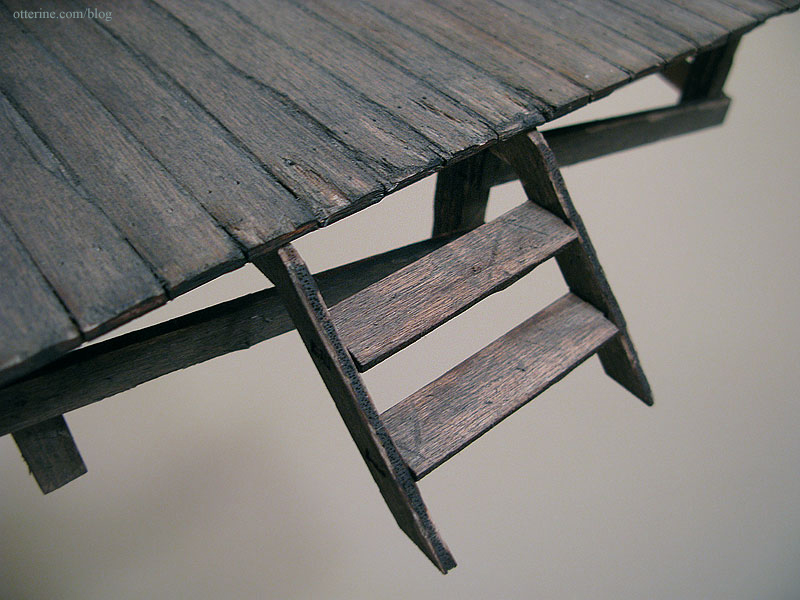
This created a really nice walking wear pattern at the top of the stairs.
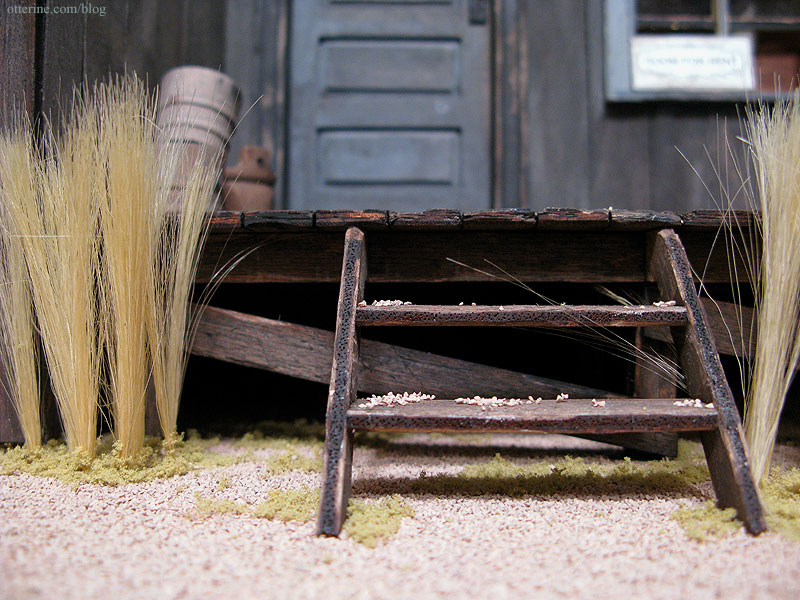
I kept the landscaping simple, using Woodland Scenics, ballast, foam ground cover and field grass. The Woodland Scenics materials were awesome to work with, and I highly recommend them.
I didn’t want to clutter the front of the barn too much, but I had bought a few unpainted metal miniatures that I thought would add to the overall feel. These I painted with Testors flat black and then “rusted” with various acrylics.
I aged some balsa scraps with the same paint wash as the exterior and glued the metal hitching posts on top. I glued them a bit askew to make it look like they’ve been there awhile and tugged on a bit by ornery horses. The metal tub was silver, but I beat it up to dent it and then painted it to make it look old and rusted (here is a photo before the field grass was added).
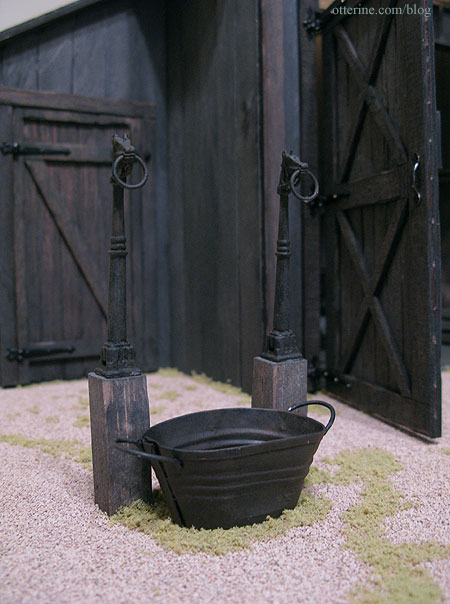
The other piece I added was the water pump. I made the base from balsa, battering the edges of the wood slats and using my awl to add nail holes before aging it with a paint wash. I glued a bit of the ground cover material to make it look as though plants were growing through the boards. The metal bucket was silver metal when I bought it.
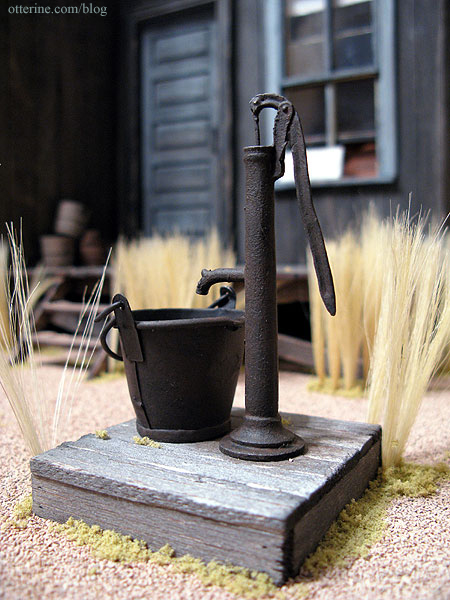
The birds nest was made using an online tutorial as a starting point, but I used what I had on hand instead of their suggested materials. It’s about 7/8″ in diameter, maybe a bit large for scale but pretty close for my first attempt. The bird is by Falcon Miniatures.
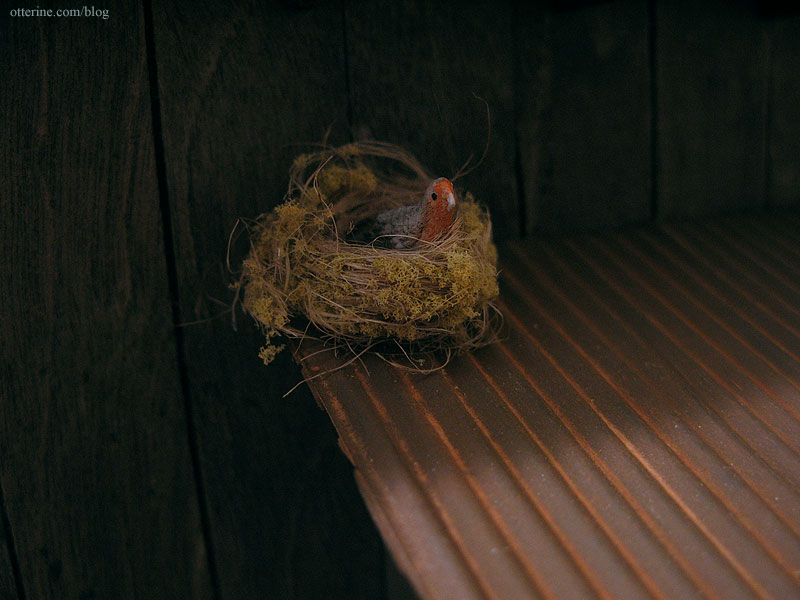
My initial idea for the tin roof was corrugated cardboard painted to simulate tin since I’ve seen that done before with good results, but I found two items that allowed me to go for an even more durable finish. The first was a pack of 12 metal sheets with an adhesive backing. Each sheet measured 4″ x 12″ and the pack was very reasonable in price – $5 at Hobby Lobby. I then bought a paper crimper by Fiskars to turn 4″ x 6″ pieces of the metal sheet into corrugated tin roofing. :D
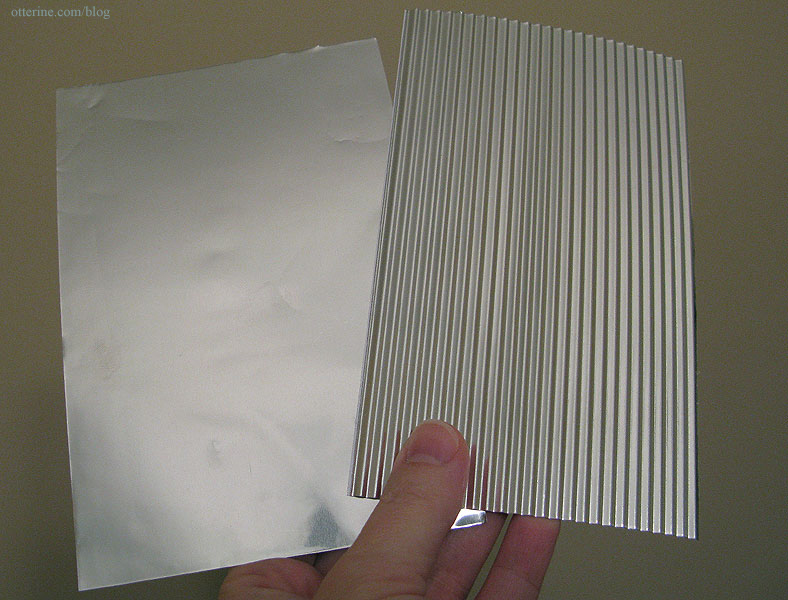
After transferring the pieces onto a foil covered board, I sprayed them with a thin coat of Testors flat black spray paint. Once the black paint was dry, I started layering different colors of paint using a stencil brush. I used Bittersweet Chocolate by Americana, Coffee Bean by Folk Art and Terra Cotta by Americana. Once I had a good base of brown and rust colors, I used a watered down wash of the Terra Cotta paint to smooth the surface.
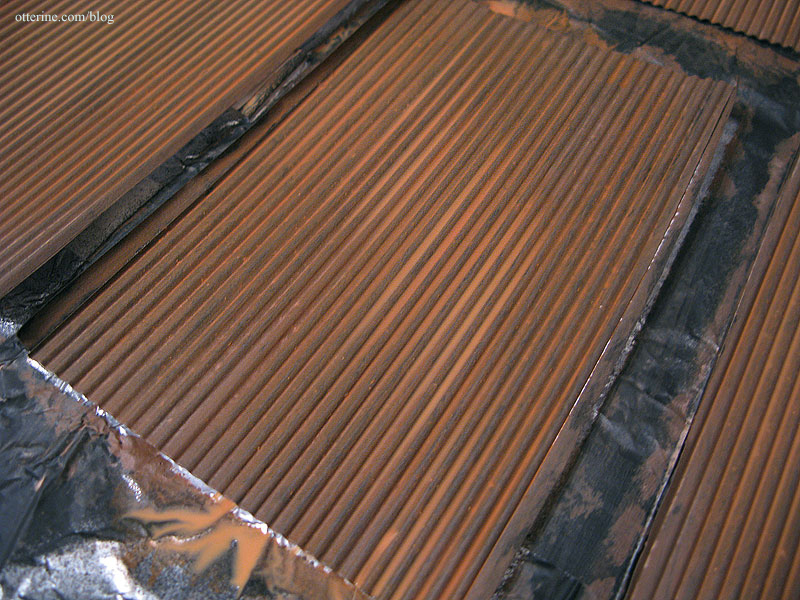
I love the way it turned out. :D
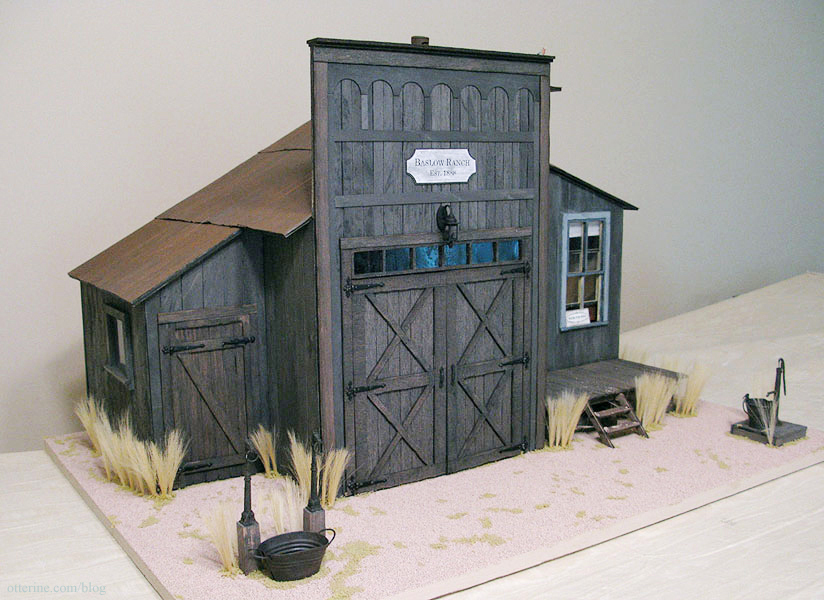
The chimney was made from spare bits and bobs. I glued the pieces together and then sprayed with Testors flat black. I “rusted” it with paint and glued it to the roof. (I didn’t make a connecting pipe inside the barn – I have to draw the line of sanity somewhere!!!)
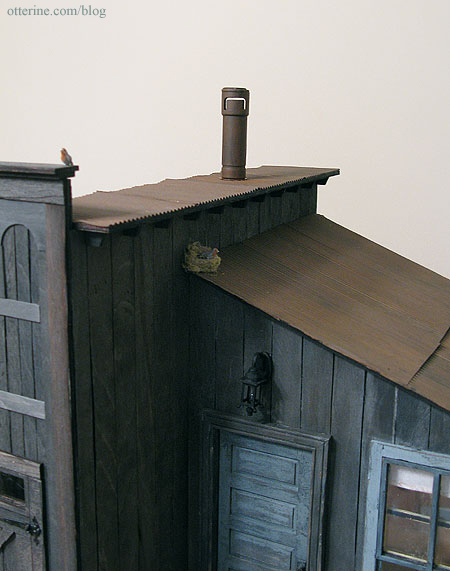
The Burrowing Owl was added well after the build was completed. Kerri Pajutee has two great tutorials on CDHM: one for sculpting a bird and another on flocking and feathering. I used those as a basis to start my mini owl.
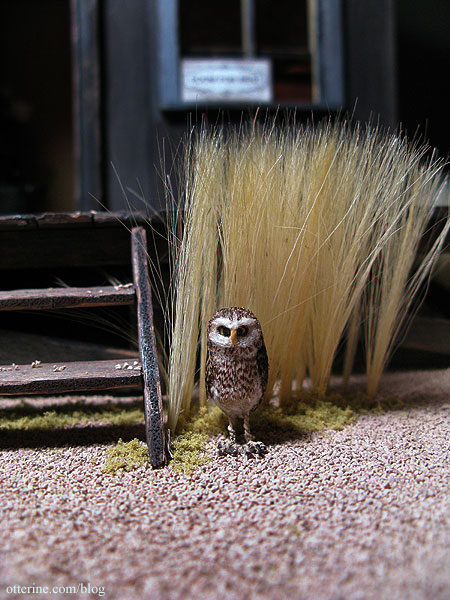
I don’t think I did half bad my first time around if I do say so myself, and he looks right at home at the Ranch! :D
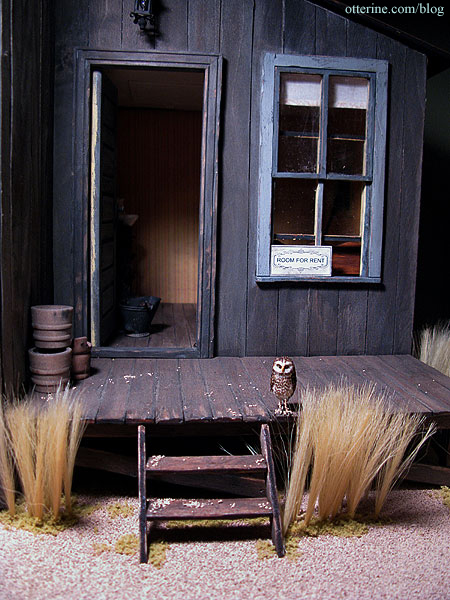
The attic was a lot of fun. I’ve seen other miniaturists’ attics with newspaper wallpaper, and I wanted to do something similar. I took images from newspapers online, resized and printed sheets on two shades of parchment paper I had in my stash from my old art school days. The subtle translucent quality and the mottled coloration added a lot of realism. Then came the task of cutting out each individual page of newsprint so I could apply the paper piece by piece.
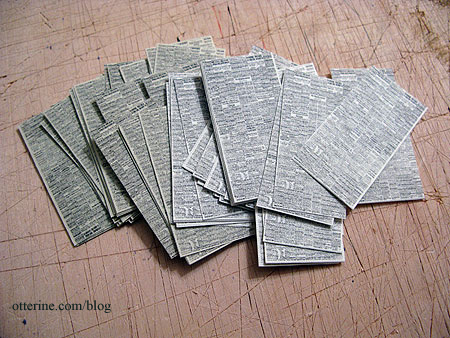
Once the attic floor was in place, I glued beams along the walls, leaving 1 1/2″ between them. I used the individual newspaper pieces to cover the sections between the beams, mashing the paper, gluing wrinkles in place and turning some corners down. I used the same process on the ceiling portion of the attic and added some water spots with a brown paint wash.
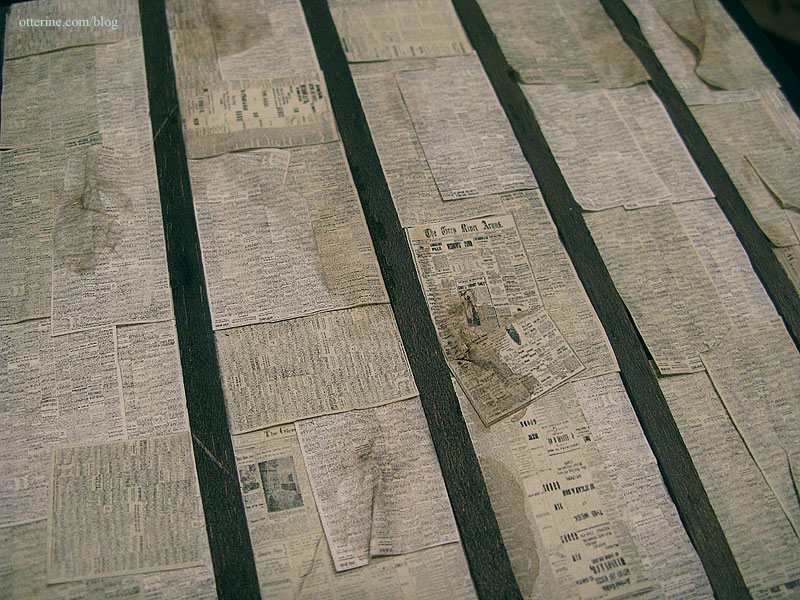
I love it! :D And, the great thing about this room is that the older and dustier it gets over the years, the more realistic it will look.
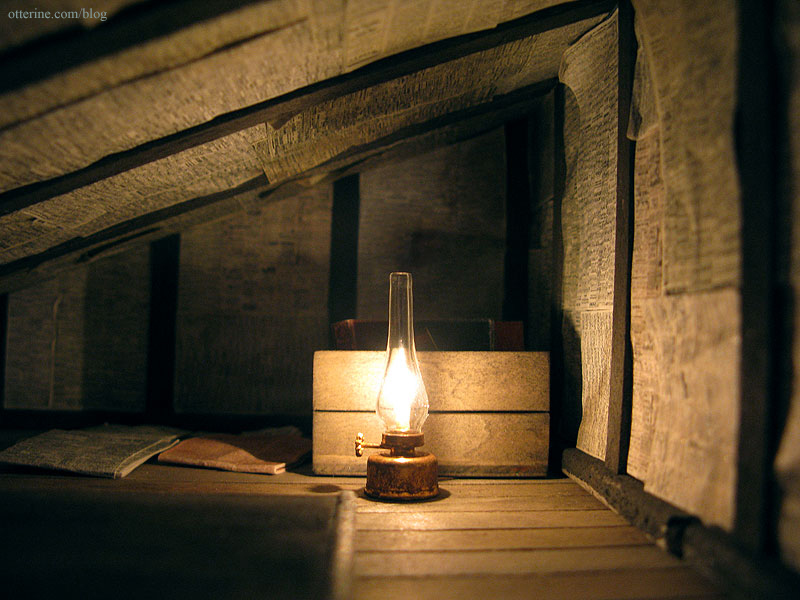
Update from 2012: In addition to the light coating of dust from the past two years, the barn has apparently attracted the attention of small spiders — as barns are apt to do. There is a fine covering of webs inside the top of the barn by the lights.
Quite marvelous, don’t you think? :D It’s interesting to me since the lights aren’t often on and they wouldn’t really attract insects of any sort besides, but this is exactly where spiders would congregate in a real life barn — the perfect place to catch any insects attracted to the lights.
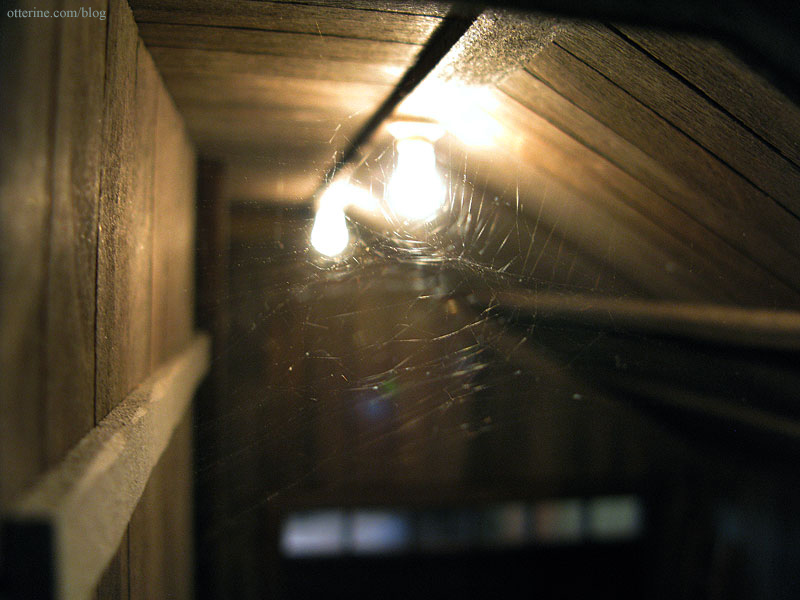
They aren’t shown in this photo, but the webs continue under the slight lip of the roof outside this wall, too. I suppose someday I’ll have to dust the house and remove the webs when they become overwhelming, but not yet.
Categories: Baslow Ranch
April 15, 2011 | 2 commentsDollhouse miniature ice cubes
There are so many creative people out there who are incredibly generous to share their ideas on homemade and often inexpensive minis. The first time I saw mini ice cubes made from suction cups on My Small Obsession, I was amazed at how realistic they looked.
So, I went to the dollar store and bought a pack of suction cups. I cut them into strips and then into tiny cubes. I didn’t measure or try to make them perfect. In fact, I used all but the thinnest edge of the cups and tried to vary the size and shape. I wanted them to look like full cubes, broken cubes and shards. This is the amount of ice two 1 5/8″ diameter suction cups made.

The ones I bought were a bit bluish in tone, and my ice cubes also turned out to be on the blue side. I worried that this might detract from their realism until I added a couple of mini beer bottles to a tub full of them. :D I think they look wonderful!

Categories: Miniatures
April 12, 2011 | 0 commentsVintage Millie August furniture kits
I found these two kits at a local hobby store that was having a moving sale. The fabric seemed a bit rough for scale, though the finished photos on the kits looked wonderful.
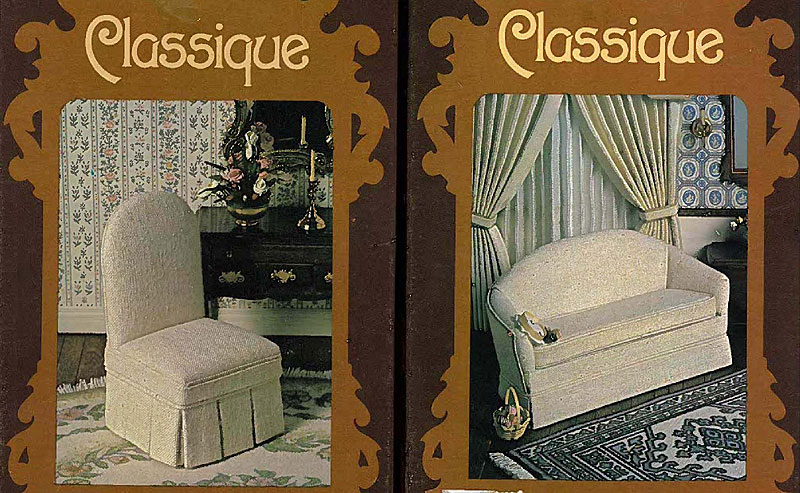
I had some ivory muslin in my fabric stash that seemed softer, but I stuck with the original fabric in the end and was glad I did. :D
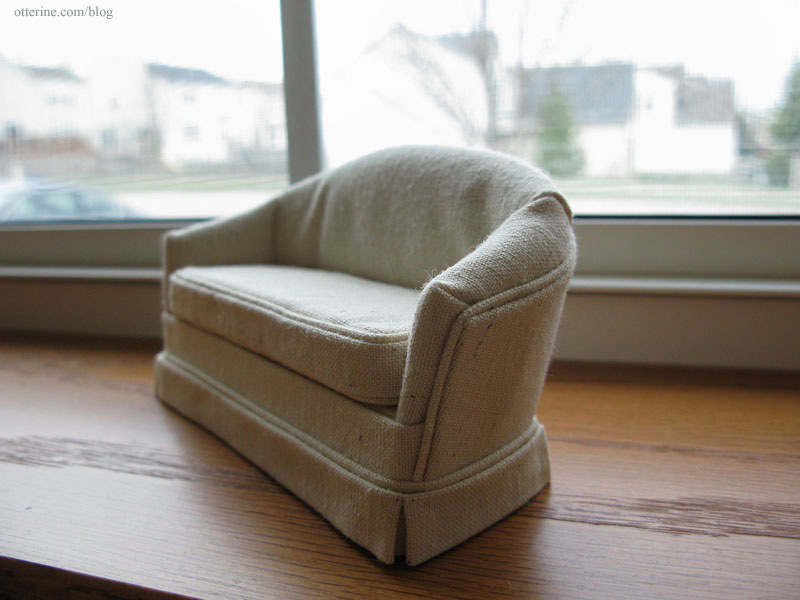
My general impression was these kits are very thorough and have excellent detailed instructions, though there were parts that had no illustrations when you could have used some. I chose to make a photocopy of the pattern pieces before cutting them just in case I had to start over with my muslin fabric. I also copied the figure drawings so I didn’t have to keep flipping the paper over between the instructions and the drawings, which happened to be on opposite sides from one another.
I tackled the couch first, and it went well from the start. Since the kit was old, the foam had yellowed significantly, so I lined the sides and front of the couch with natural muslin before adding the finished fabric. I didn’t want to take the chance that the yellow would show through once the couch was complete.
The most challenging part was creating the welting, or cording, but it’s the one element that really adds to the realism of the piece. Real life sized upholstered furniture has this detailing and it was worth the frustration and effort to get it to work.
All in all, the couch took me the better part of a day to put together, so I haven’t gotten to the chair just yet.
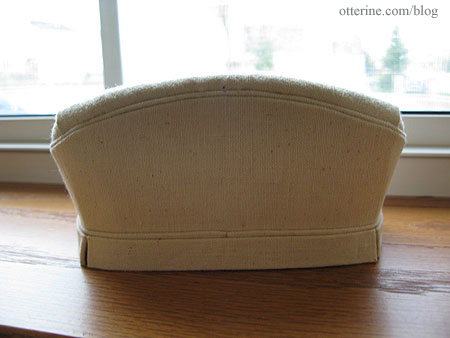
I added some green plaid pillows.
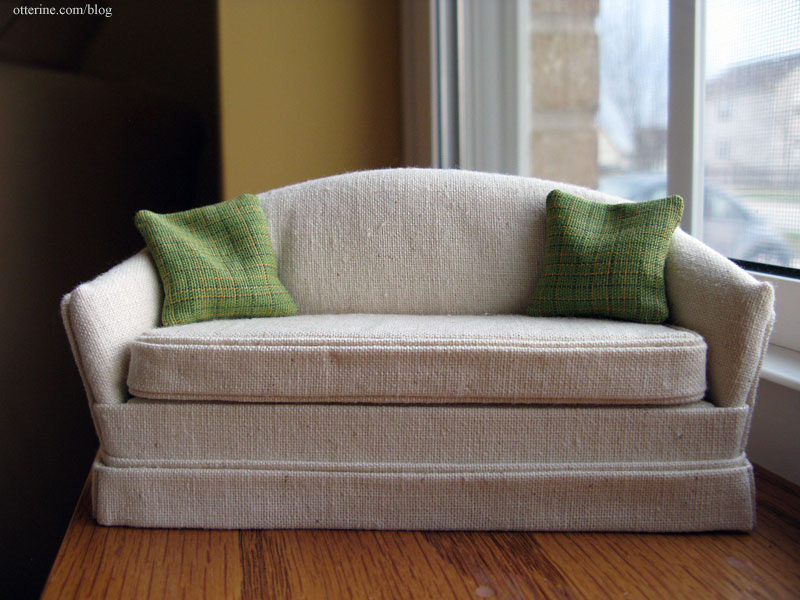
The kit has you build the couch as you would build one in real life size. I learned a lot putting this kit together and will put these skills to use the next time I make an upholstered item.
Ara, who has a blog called Addams Family Mini-Mansion, uses a small wood artist’s model when she builds custom furniture. I thought this was a brilliant idea, so I bought a couple myself from Barnes & Noble to use when either making kits as in this case or for when I get around to scratch-building more furniture. They are 5 3/4″ tall, so they equate to a person about 5’9″, which is perfect for getting the proper scale of things. They don’t articulate all that well, but they do a good job for me since I have no actual dolls to put in my miniature dwellings. :]
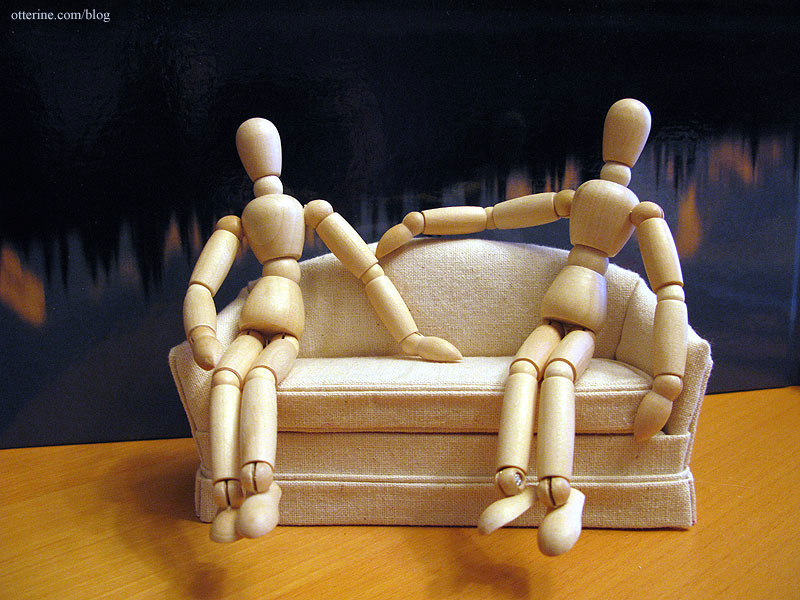
For the chair, I found the instructions to be a little lacking in comparison to the couch, so I was glad I finished the other kit first. It helped me figure out what to do when I wasn’t sure about the directions. The couch didn’t have an exact side chair counterpart, but I thought this would work well as an alternative. But, I didn’t want it to look like a vanity chair so much as a comfortable modern chair.
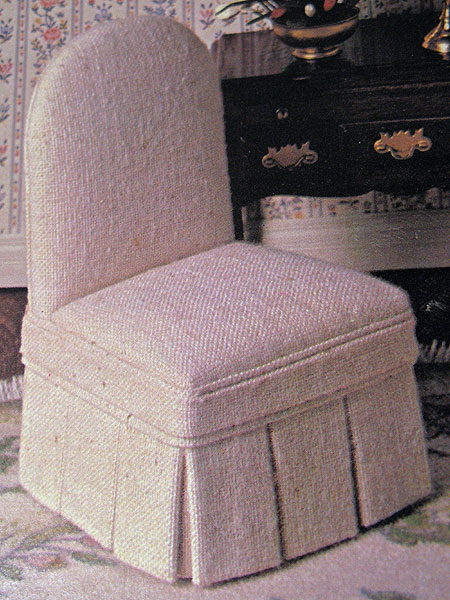
To that end, I cut off the top curve on the back.
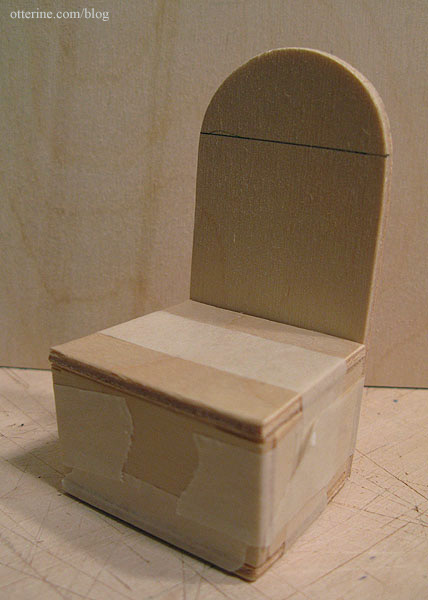
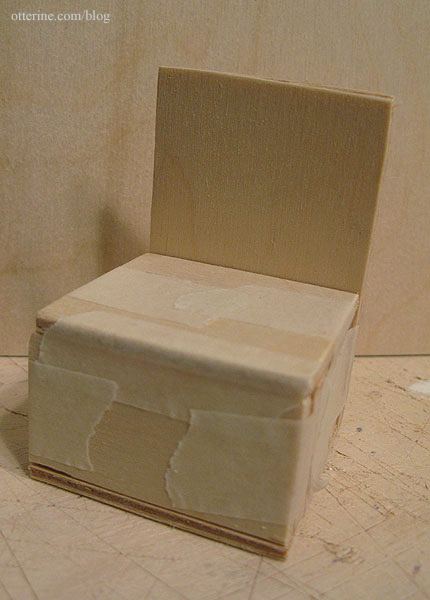
Initially, instead of doing the multiple pleats around the chair, I mimicked the skirting I had done for the sofa to tie the two pieces together.
It turned out okay, but I felt it didn’t have the same polish as the couch. The problem was that the original design took all the extra fabric from pleated skirts into consideration and therefore the seat was cut large. I didn’t cut the seat down when that step came around not thinking about this end result…so my skirts ended up looking too thin for the overall lines of the chair. I didn’t care for the bulge in the middle.
My only real option was to remove the outer trim and the skirts and cut new pieces from the spare fabric included in the kit, because removing the seat assembly to cut it down would have meant tearing the whole thing apart. Not at all tempting.
I still didn’t want the multiple pleats, but I had to assemble one to see how thick it was. Once I had that measurement, I was able to figure out how much thickness I needed to add around the base to make up for the lack of the pleats. I added 1/16″ thick balsa wood around the sides and front.
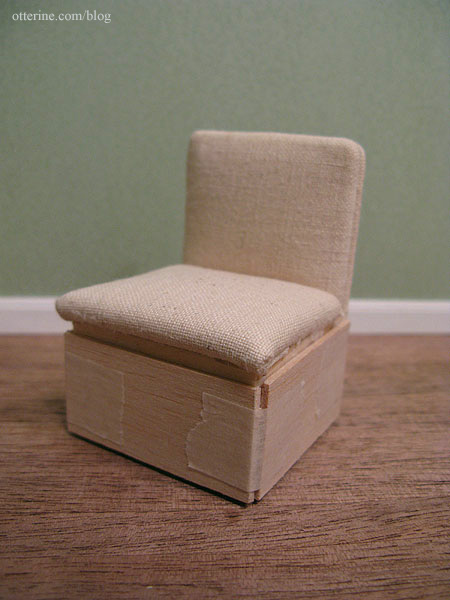
I cut new corner pieces, skirts and the thin finishing trim. I was able to salvage one piece of trim from the first go around, but it was a little short in the back once fully assembled…but we won’t look at the back. I reassembled the skirts and trim and ended up with a much better result.
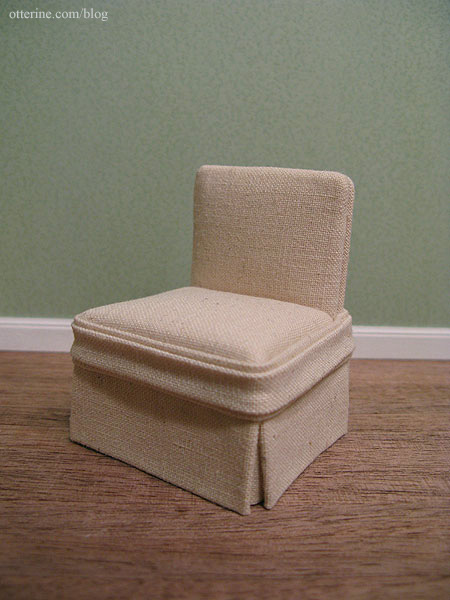
I still like the couch better overall, but the chair fits with the couch nicely enough, I think.
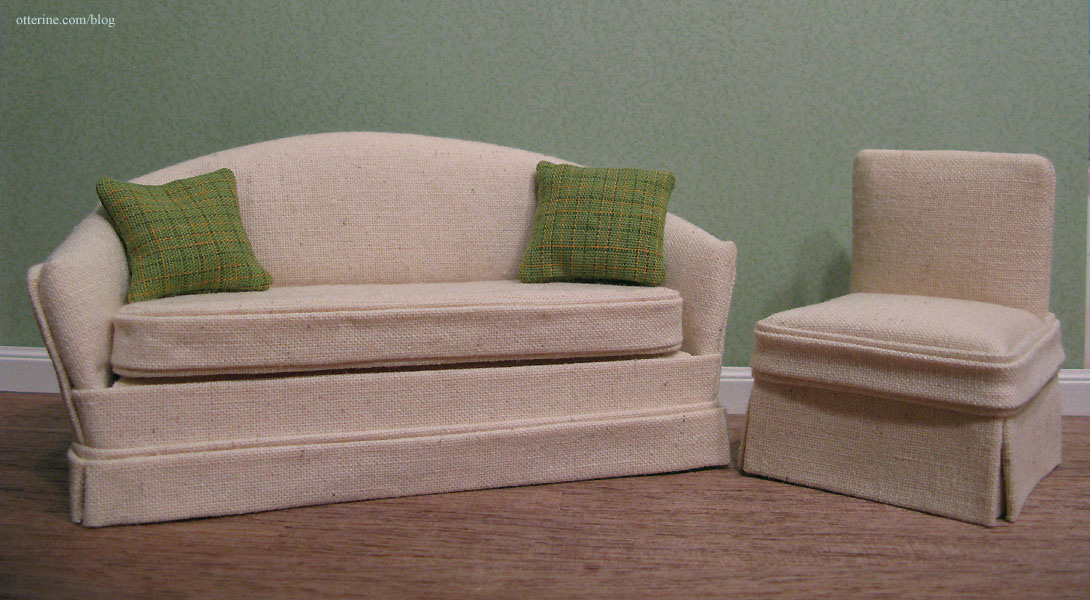
Categories: Baxter Pointe Villa, Furniture
April 10, 2011 | 0 comments
NOTE: All content on otterine.com is copyrighted and may not be reproduced in part or in whole. It takes a lot of time and effort to write and photograph for my blog. Please ask permission before reproducing any of my content. Please click for copyright notice and Pinterest use.






































